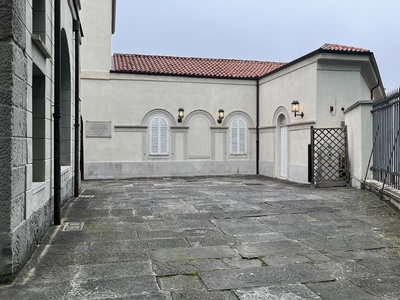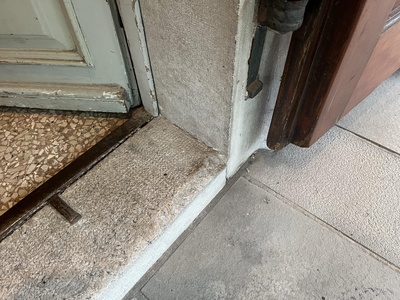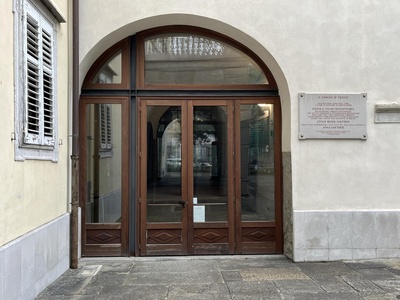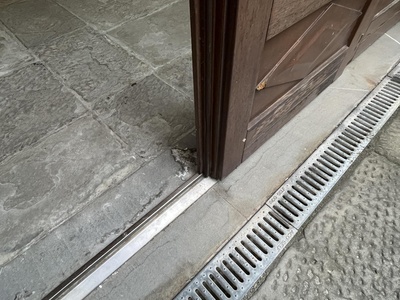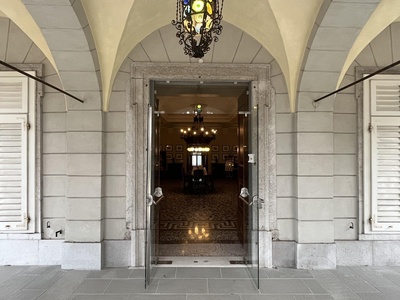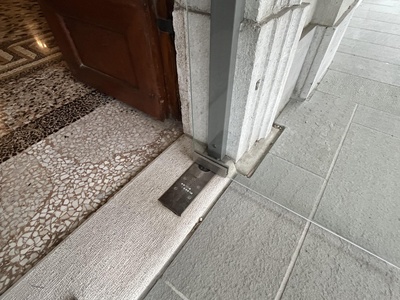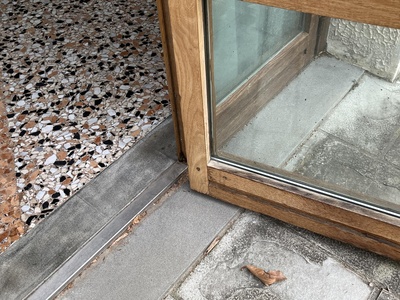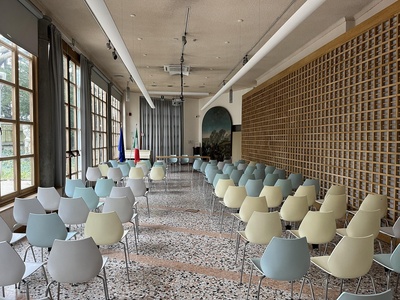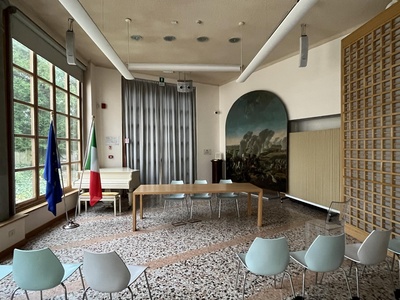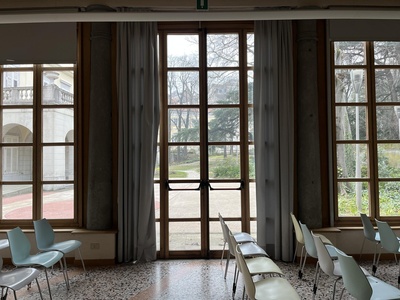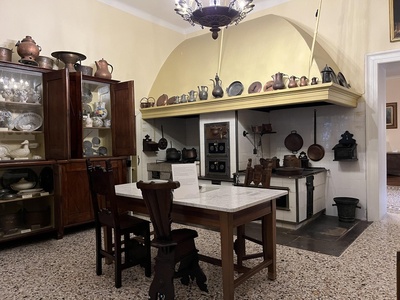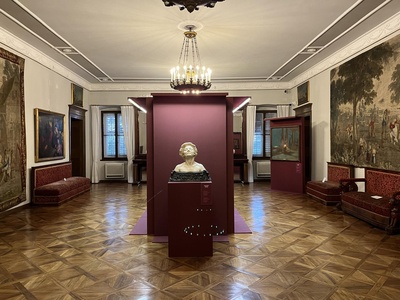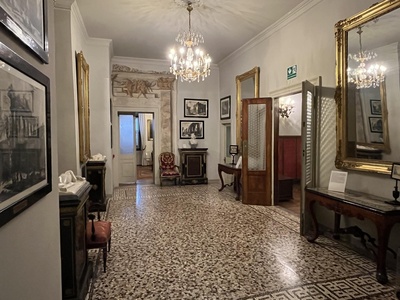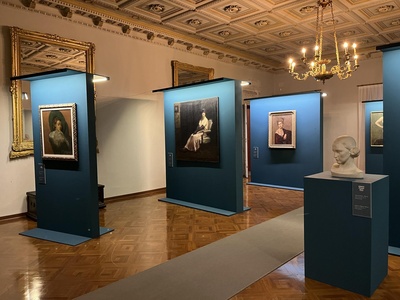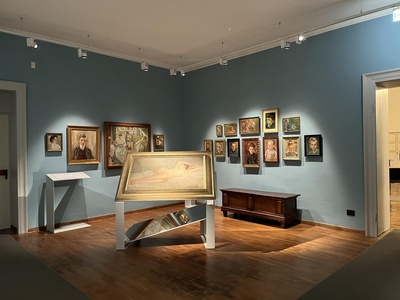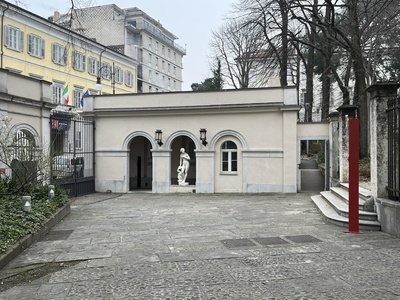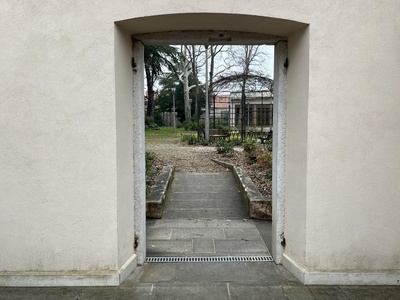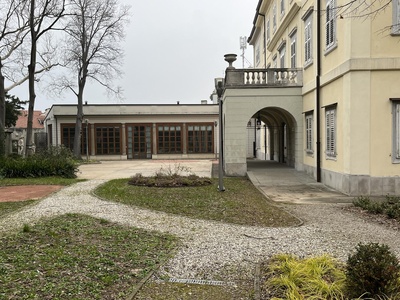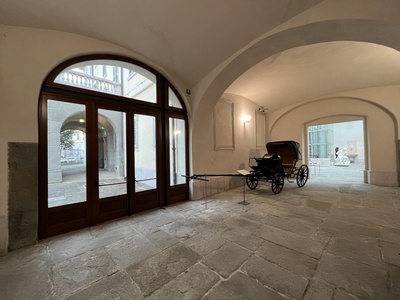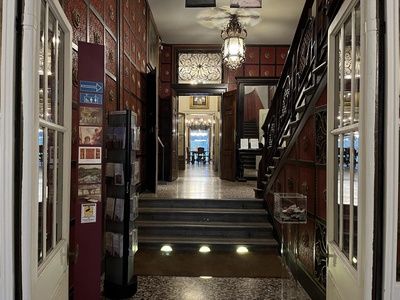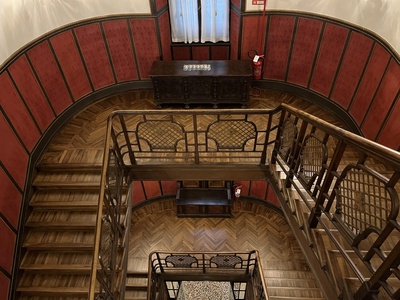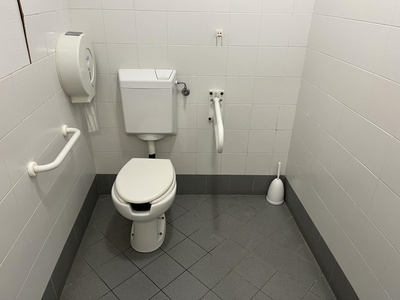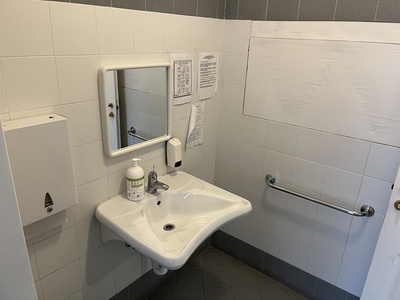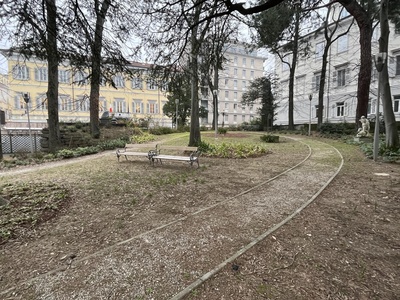Civic Museum Sartorio

Sea
2.4 /3
GENERAL INFORMATION
Address
largo Papa Giovanni XXIII, 1 34123 Trieste (Trieste)
PHONE NUMBER
WEB SITE
The Sartorio Museum is an example of a "house museum" set in an elegant bourgeois villa built in the 18th century and expanded in the neoclassical era, located a short distance from the sea and surrounded by a garden. The Museum was opened to the public in March 1954 and, over the years, alongside the original collection, it has become a treasure trove to host other collections, owned or on deposit at the Civic Museums of History and Art – Rusconi-Opuich, Costantinides, Piperata, Gipsoteca-Gliptoteca, Masterpieces of Istria – which expand its exhibition offerings. In 2006, it was reopened to the public following its complete restoration. Inside the Sartorio Museum, the furnishings, artworks, and everyday objects are part of an exhibition path that unfolds over three floors: in the interconnected salons, the Empire and Biedermeier styles coexist, up to the historical revival, neo-Gothic, and neo-Rococo. The Museum is surrounded by a small English-style park. The statues that adorn it were transferred there in 1994 from Villa Carolina in Montebello, which belonged to the Sartorio family, and once decorated the Gradenigo villa on the Terraglio in Veneto. The "Silvio Rutteri" gipsoteca-gliptoteca is currently closed to the public and can only be visited by appointment, as well as the "Laura Ruaro Loseri" Gallery, located in the former stables with paintings from the collections of the Civic Museums of History and Art (during special openings). From the Gipsoteca room, access to the Basement is available via an elevator, where there are: a representative collection of Italian ceramics from the Middle Ages to the 19th century, structural elements related to a Roman coastal domus or villa dating back to the 1st century AD, particularly a mosaic floor made of white limestone tiles, and a collection of jewelry, bijoux, holy water fonts, ceramics, glass, and silver from the 19th and 20th centuries donated by Fulvia Costantinides. The Basement is currently not accessible to the public. The above situation is linked to the current staffing levels, which do not allow for the supervised opening of the aforementioned rooms. The structure does not have an area or room dedicated to a Bookshop and Cloakroom as it is awaiting evaluation of the application for related funding from the appropriate authority.
LAST INSPECTION DATE
ACCESSIBILITY DATA
1.8/3
Private parking
PRESENT:
{'label': 'Present', 'order': 0, 'value': 'Present and with adequate capacity compared to the structure'} Present and with adequate capacity compared to the structurePrivate parking characteristics
TYPE:
{'label': 'Type', 'order': 1, 'value': 'Open outdoor'} Open outdoorPAVEMENT:
{'label': 'Pavement', 'order': 1, 'value': 'Uneven concrete/porphyry blocks, cobblestone, grass, wood'} Uneven concrete/porphyry blocks, cobblestone, grass, woodRESERVED STALL:
{'label': 'Reserved stall', 'order': 1, 'value': 'Sì'} SìSTALL:
- {'label': '', 'order': 0, 'value': '', 'features': [{'label': 'Number of stalls', 'order': 1, 'value': 1}, {'label': '', 'order': 2, 'value': '', 'features': [{'label': 'Width (cm)', 'order': 1, 'value': 250}, {'label': 'Length (cm)', 'order': 2, 'value': 500}]}, {'label': '', 'order': 4, 'value': '', 'features': [{'label': 'Pavement', 'order': 1, 'value': 'Uneven concrete/porphyry blocks, cobblestone, grass, wood'}]}]}
NUMBER OF STALLS:
{'label': 'Number of stalls', 'order': 1, 'value': 1} 1{'label': '', 'order': 2, 'value': '', 'features': [{'label': 'Width (cm)', 'order': 1, 'value': 250}, {'label': 'Length (cm)', 'order': 2, 'value': 500}]}WIDTH (CM):
{'label': 'Width (cm)', 'order': 1, 'value': 250} 250LENGTH (CM):
{'label': 'Length (cm)', 'order': 2, 'value': 500} 500{'label': '', 'order': 4, 'value': '', 'features': [{'label': 'Pavement', 'order': 1, 'value': 'Uneven concrete/porphyry blocks, cobblestone, grass, wood'}]}PAVEMENT:
{'label': 'Pavement', 'order': 1, 'value': 'Uneven concrete/porphyry blocks, cobblestone, grass, wood'} Uneven concrete/porphyry blocks, cobblestone, grass, wood
Path from the reserved stall (or closest to the access) to a building access
PAVEMENT:
{'label': 'Pavement', 'order': 1, 'value': 'Concrete/Asphalt or level stone, Uneven concrete/porphyry blocks, cobblestone, grass, wood'} Concrete/Asphalt or level stone, Uneven concrete/porphyry blocks, cobblestone, grass, woodMAIN WIDTH:
{'label': 'Main width', 'order': 2, 'value': '', 'features': [{'label': 'Type', 'order': 1, 'value': '> 90 cm'}]}TYPE:
{'label': 'Type', 'order': 1, 'value': '> 90 cm'} > 90 cmCOVERAGE:
{'label': 'Coverage', 'order': 1, 'value': 'No'} NoTACTILE PATHS:
{'label': 'Tactile paths', 'order': 1, 'value': 'No'} NoHeight difference (> 2.5 cm)
PRESENT:
{'label': 'Present', 'order': 1, 'value': 'No'} NoBuilding access
ENTRANCE:
{'label': 'Entrance', 'order': 0, 'value': 'Entrance already registered with the entrance form, as main'} Entrance already registered with the entrance form, as mainGeneral note
2.2/3
Floor
Entrance type
ACCESSIBLE:
{'label': 'Accessible', 'order': 1, 'value': 'Yes'} YesTYPE:
{'label': 'Type', 'order': 2, 'value': 'Main'} MainHeight difference (> 2.5 cm)
PRESENT:
{'label': 'Present', 'order': 1, 'value': 'Yes'} YesHEIGHT DIFFERENCE:
- {'label': '', 'order': 0, 'value': '', 'features': [{'label': 'Type', 'order': 1, 'value': 'Short staircase/Step'}, {'label': 'Unique code', 'order': 2, 'value': 'SB1'}, {'label': 'Short staircase/Step (lower than a floor)', 'order': 4, 'value': '', 'features': [{'label': 'Width (cm)', 'order': 1, 'value': 142}, {'label': 'Number of steps', 'order': 2, 'value': 1}, {'label': 'Height of single rise (cm)', 'order': 3, 'value': 9}, {'label': 'Handrail', 'order': 4, 'value': '', 'features': [{'label': 'Present', 'order': 1, 'value': 'No'}]}, {'label': 'Step', 'order': 5, 'value': '', 'features': [{'label': 'Type', 'order': 1, 'value': 'Non-slip, Color contrast'}, {'label': 'Note', 'order': 3, 'value': 'Gray / Stone / Venetian mosaic'}]}, {'label': 'Intermediate landing', 'order': 6, 'value': 'No'}, {'label': '', 'order': 7, 'value': '', 'features': [{'label': 'Tactile paths', 'order': 1, 'value': 'No'}]}]}]}
TYPE:
{'label': 'Type', 'order': 1, 'value': 'Short staircase/Step'} Short staircase/StepUNIQUE CODE:
{'label': 'Unique code', 'order': 2, 'value': 'SB1'} SB1SHORT STAIRCASE/STEP (LOWER THAN A FLOOR):
{'label': 'Short staircase/Step (lower than a floor)', 'order': 4, 'value': '', 'features': [{'label': 'Width (cm)', 'order': 1, 'value': 142}, {'label': 'Number of steps', 'order': 2, 'value': 1}, {'label': 'Height of single rise (cm)', 'order': 3, 'value': 9}, {'label': 'Handrail', 'order': 4, 'value': '', 'features': [{'label': 'Present', 'order': 1, 'value': 'No'}]}, {'label': 'Step', 'order': 5, 'value': '', 'features': [{'label': 'Type', 'order': 1, 'value': 'Non-slip, Color contrast'}, {'label': 'Note', 'order': 3, 'value': 'Gray / Stone / Venetian mosaic'}]}, {'label': 'Intermediate landing', 'order': 6, 'value': 'No'}, {'label': '', 'order': 7, 'value': '', 'features': [{'label': 'Tactile paths', 'order': 1, 'value': 'No'}]}]}WIDTH (CM):
{'label': 'Width (cm)', 'order': 1, 'value': 142} 142NUMBER OF STEPS:
{'label': 'Number of steps', 'order': 2, 'value': 1} 1HEIGHT OF SINGLE RISE (CM):
{'label': 'Height of single rise (cm)', 'order': 3, 'value': 9} 9HANDRAIL:
{'label': 'Handrail', 'order': 4, 'value': '', 'features': [{'label': 'Present', 'order': 1, 'value': 'No'}]}PRESENT:
{'label': 'Present', 'order': 1, 'value': 'No'} NoSTEP:
{'label': 'Step', 'order': 5, 'value': '', 'features': [{'label': 'Type', 'order': 1, 'value': 'Non-slip, Color contrast'}, {'label': 'Note', 'order': 3, 'value': 'Gray / Stone / Venetian mosaic'}]}TYPE:
{'label': 'Type', 'order': 1, 'value': 'Non-slip, Color contrast'} Non-slip, Color contrastNOTE:
{'label': 'Note', 'order': 3, 'value': 'Gray / Stone / Venetian mosaic'} Gray / Stone / Venetian mosaicINTERMEDIATE LANDING:
{'label': 'Intermediate landing', 'order': 6, 'value': 'No'} No{'label': '', 'order': 7, 'value': '', 'features': [{'label': 'Tactile paths', 'order': 1, 'value': 'No'}]}TACTILE PATHS:
{'label': 'Tactile paths', 'order': 1, 'value': 'No'} No
Threshold (< 2.5 cm)
PRESENT:
{'label': 'Present', 'order': 1, 'value': 'Yes'} YesEntrance door
TYPE:
{'label': 'Type', 'order': 1, 'value': 'Double leaf or with two opening elements'} Double leaf or with two opening elementsOPENING DIRECTION:
{'label': 'Opening direction', 'order': 1, 'value': 'Inside'} InsideAUTOMATED OPENING:
{'label': 'Automated opening', 'order': 2, 'value': 'No'} NoCLEAR DOOR WIDTH:
{'label': 'Clear door width', 'order': 1, 'value': 'Double leaf or with two opening elements'} Double leaf or with two opening elementsOVERALL OPENING (CM):
{'label': 'Overall opening (cm)', 'order': 1, 'value': 136} 136MAIN LEAF (CM):
{'label': 'Main leaf (cm)', 'order': 1, 'value': 68} 68FLUSHNESS OF DOOR LEAVES (NOT EVALUATED FOR HEIGHT DIFFERENCE UP TO 2.5 CM):
{'label': 'Flushness of door leaves (not evaluated for height difference up to 2.5 cm)', 'order': 5, 'value': 'Yes'} YesDOORMATS/RUGS:
{'label': 'Doormats/Rugs', 'order': 6, 'value': '', 'features': [{'label': 'Present', 'order': 1, 'value': 'No'}]}PRESENT:
{'label': 'Present', 'order': 1, 'value': 'No'} NoINTERCOM/BELL:
{'label': 'Intercom/Bell', 'order': 7, 'value': '', 'features': [{'label': 'Present', 'order': 1, 'value': 'No'}]}PRESENT:
{'label': 'Present', 'order': 1, 'value': 'No'} NoGlass doors: window stickers to indicate their presence
RELEVANT:
{'label': 'Relevant', 'order': 1, 'value': 'Sì'} SìPRESENT:
{'label': 'Present', 'order': 2, 'value': 'No'} NoCOMMENTS:
{'label': 'Comments', 'order': 3, 'value': 'The lower part of the frame is blind.'} The lower part of the frame is blind.2.2/3
Entrance type
ACCESSIBLE:
{'label': 'Accessible', 'order': 1, 'value': 'Yes'} YesTYPE:
{'label': 'Type', 'order': 2, 'value': 'Secondary'} SecondaryLOCATION RELATIVE TO THE MAIN ONE:
{'label': 'Location relative to the main one', 'order': 1, 'value': 'It is located to the right of the main entrance near the parking lot.'} It is located to the right of the main entrance near the parking lot.SECONDARY ENTRANCE INDICATION:
{'label': 'Secondary entrance indication', 'order': 2, 'value': 'The entrance is accessible with prior notice at the reception.'} The entrance is accessible with prior notice at the reception.Height difference (> 2.5 cm)
PRESENT:
{'label': 'Present', 'order': 1, 'value': 'Yes'} YesHEIGHT DIFFERENCE:
- {'label': '', 'order': 0, 'value': '', 'features': [{'label': 'Type', 'order': 1, 'value': 'Ramp'}, {'label': 'Unique code', 'order': 2, 'value': 'RA10'}, {'label': 'Ramp', 'order': 6, 'value': '', 'features': [{'label': 'Width (cm)', 'order': 1, 'value': 180}, {'label': 'Length (cm)', 'order': 2, 'value': 5}, {'label': 'Slope', 'order': 3, 'value': '', 'features': [{'label': 'Slope (°)', 'order': 1, 'value': 45}, {'label': 'Slope (%)', 'order': 2, 'value': 100}]}, {'label': 'Handrail', 'order': 4, 'value': '', 'features': [{'label': 'Present', 'order': 1, 'value': 'No'}]}, {'label': 'Side curb threshold', 'order': 5, 'value': 'No'}, {'label': 'Non-slip finish', 'order': 6, 'value': 'No'}, {'label': '', 'order': 7, 'value': '', 'features': [{'label': 'Chromatic contrast', 'order': 1, 'value': 'Sì'}, {'label': 'Note', 'order': 2, 'value': 'Steel element between stone.'}]}, {'label': '', 'order': 8, 'value': '', 'features': [{'label': 'Tactile-plantar paths', 'order': 1, 'value': 'No'}]}]}]}
TYPE:
{'label': 'Type', 'order': 1, 'value': 'Ramp'} RampUNIQUE CODE:
{'label': 'Unique code', 'order': 2, 'value': 'RA10'} RA10RAMP:
{'label': 'Ramp', 'order': 6, 'value': '', 'features': [{'label': 'Width (cm)', 'order': 1, 'value': 180}, {'label': 'Length (cm)', 'order': 2, 'value': 5}, {'label': 'Slope', 'order': 3, 'value': '', 'features': [{'label': 'Slope (°)', 'order': 1, 'value': 45}, {'label': 'Slope (%)', 'order': 2, 'value': 100}]}, {'label': 'Handrail', 'order': 4, 'value': '', 'features': [{'label': 'Present', 'order': 1, 'value': 'No'}]}, {'label': 'Side curb threshold', 'order': 5, 'value': 'No'}, {'label': 'Non-slip finish', 'order': 6, 'value': 'No'}, {'label': '', 'order': 7, 'value': '', 'features': [{'label': 'Chromatic contrast', 'order': 1, 'value': 'Sì'}, {'label': 'Note', 'order': 2, 'value': 'Steel element between stone.'}]}, {'label': '', 'order': 8, 'value': '', 'features': [{'label': 'Tactile-plantar paths', 'order': 1, 'value': 'No'}]}]}WIDTH (CM):
{'label': 'Width (cm)', 'order': 1, 'value': 180} 180LENGTH (CM):
{'label': 'Length (cm)', 'order': 2, 'value': 5} 5SLOPE:
{'label': 'Slope', 'order': 3, 'value': '', 'features': [{'label': 'Slope (°)', 'order': 1, 'value': 45}, {'label': 'Slope (%)', 'order': 2, 'value': 100}]}SLOPE (°):
{'label': 'Slope (°)', 'order': 1, 'value': 45} 45SLOPE (%):
{'label': 'Slope (%)', 'order': 2, 'value': 100} 100HANDRAIL:
{'label': 'Handrail', 'order': 4, 'value': '', 'features': [{'label': 'Present', 'order': 1, 'value': 'No'}]}PRESENT:
{'label': 'Present', 'order': 1, 'value': 'No'} NoSIDE CURB THRESHOLD:
{'label': 'Side curb threshold', 'order': 5, 'value': 'No'} NoNON-SLIP FINISH:
{'label': 'Non-slip finish', 'order': 6, 'value': 'No'} No{'label': '', 'order': 7, 'value': '', 'features': [{'label': 'Chromatic contrast', 'order': 1, 'value': 'Sì'}, {'label': 'Note', 'order': 2, 'value': 'Steel element between stone.'}]}CHROMATIC CONTRAST:
{'label': 'Chromatic contrast', 'order': 1, 'value': 'Sì'} SìNOTE:
{'label': 'Note', 'order': 2, 'value': 'Steel element between stone.'} Steel element between stone.{'label': '', 'order': 8, 'value': '', 'features': [{'label': 'Tactile-plantar paths', 'order': 1, 'value': 'No'}]}TACTILE-PLANTAR PATHS:
{'label': 'Tactile-plantar paths', 'order': 1, 'value': 'No'} No
Threshold (< 2.5 cm)
PRESENT:
{'label': 'Present', 'order': 1, 'value': 'Yes'} YesHEIGHT (CM):
{'label': 'Height (cm)', 'order': 2, 'value': 2} 2Entrance door
TYPE:
{'label': 'Type', 'order': 1, 'value': 'Double leaf or with two opening elements'} Double leaf or with two opening elementsOPENING DIRECTION:
{'label': 'Opening direction', 'order': 1, 'value': 'Outward'} OutwardAUTOMATED OPENING:
{'label': 'Automated opening', 'order': 2, 'value': 'No'} NoCLEAR DOOR WIDTH:
{'label': 'Clear door width', 'order': 1, 'value': 'Double leaf or with two opening elements'} Double leaf or with two opening elementsOVERALL OPENING (CM):
{'label': 'Overall opening (cm)', 'order': 1, 'value': 168} 168MAIN LEAF (CM):
{'label': 'Main leaf (cm)', 'order': 1, 'value': 80} 80PLANARITY OF DOOR LEAVES (NOT EVALUATED HEIGHT DIFFERENCE UP TO 2.5 CM):
{'label': 'Planarity of door leaves (not evaluated height difference up to 2.5 cm)', 'order': 5, 'value': 'Yes'} YesDOORMATS/RUGS:
{'label': 'Doormats/Rugs', 'order': 6, 'value': '', 'features': [{'label': 'Present', 'order': 1, 'value': 'No'}]}PRESENT:
{'label': 'Present', 'order': 1, 'value': 'No'} NoINTERCOM/BELL:
{'label': 'Intercom/Bell', 'order': 7, 'value': '', 'features': [{'label': 'Present', 'order': 1, 'value': 'No'}]}PRESENT:
{'label': 'Present', 'order': 1, 'value': 'No'} NoGlass doors: window stickers to indicate their presence
RELEVANT:
{'label': 'Relevant', 'order': 1, 'value': 'Sì'} SìPRESENT:
{'label': 'Present', 'order': 2, 'value': 'No'} NoCOMMENTS:
{'label': 'Comments', 'order': 3, 'value': 'The lower part of the frame is blind.'} The lower part of the frame is blind.3/3
Floor
Entrance type
ACCESSIBLE:
{'label': 'Accessible', 'order': 1, 'value': 'Yes'} YesTYPE:
{'label': 'Type', 'order': 2, 'value': 'Secondary'} SecondaryLOCATION RELATIVE TO THE MAIN ENTRANCE:
{'label': 'Location relative to the main entrance', 'order': 1, 'value': 'It is located at the back of the building.'} It is located at the back of the building.SECONDARY ENTRANCE INDICATION:
{'label': 'Secondary entrance indication', 'order': 2, 'value': 'The entrance is accessible with prior notice at the reception.'} The entrance is accessible with prior notice at the reception.Height difference (> 2.5 cm)
PRESENT:
{'label': 'Present', 'order': 1, 'value': 'No'} NoThreshold (< 2.5 cm)
PRESENT:
{'label': 'Present', 'order': 1, 'value': 'Yes'} YesHEIGHT (CM):
{'label': 'Height (cm)', 'order': 2, 'value': 1} 1Entrance door
TYPE:
{'label': 'Type', 'order': 1, 'value': 'Double leaf or with two operable elements'} Double leaf or with two operable elementsOPENING DIRECTION:
{'label': 'Opening direction', 'order': 1, 'value': 'Outside'} OutsideAUTOMATED OPENING:
{'label': 'Automated opening', 'order': 2, 'value': 'No'} NoCLEAR DOOR WIDTH:
{'label': 'Clear door width', 'order': 1, 'value': 'Double leaf or with two operable elements'} Double leaf or with two operable elementsOVERALL OPENING (CM):
{'label': 'Overall opening (cm)', 'order': 1, 'value': 110} 110MAIN LEAF (CM):
{'label': 'Main leaf (cm)', 'order': 1, 'value': 55} 55FLUSHNESS OF DOOR LEAVES (NOT EVALUATED FOR HEIGHT DIFFERENCES UP TO 2.5 CM):
{'label': 'Flushness of door leaves (not evaluated for height differences up to 2.5 cm)', 'order': 5, 'value': 'Yes'} YesDOORMATS/RUGS:
{'label': 'Doormats/Rugs', 'order': 6, 'value': '', 'features': [{'label': 'Present', 'order': 1, 'value': 'No'}]}PRESENT:
{'label': 'Present', 'order': 1, 'value': 'No'} NoINTERCOM/BELL:
{'label': 'Intercom/Bell', 'order': 7, 'value': '', 'features': [{'label': 'Present', 'order': 1, 'value': 'No'}]}PRESENT:
{'label': 'Present', 'order': 1, 'value': 'No'} NoGlass doors: window stickers to indicate their presence
RELEVANT:
{'label': 'Relevant', 'order': 1, 'value': 'Sì'} SìPRESENT:
{'label': 'Present', 'order': 2, 'value': 'No'} No3/3
Floor
Entrance type
ACCESSIBLE:
{'label': 'Accessible', 'order': 1, 'value': 'Yes'} YesTYPE:
{'label': 'Type', 'order': 2, 'value': 'Main'} MainHeight difference (> 2.5 cm)
PRESENT:
{'label': 'Present', 'order': 1, 'value': 'No'} NoThreshold (< 2.5 cm)
PRESENT:
{'label': 'Present', 'order': 1, 'value': 'Yes'} YesHEIGHT (CM):
{'label': 'Height (cm)', 'order': 2, 'value': 1} 1Entrance door
TYPE:
{'label': 'Type', 'order': 1, 'value': 'Double leaf or with two opening elements'} Double leaf or with two opening elementsOPENING DIRECTION:
{'label': 'Opening direction', 'order': 1, 'value': 'Outside'} OutsideAUTOMATED OPENING:
{'label': 'Automated opening', 'order': 2, 'value': 'No'} NoCLEAR DOOR WIDTH:
{'label': 'Clear door width', 'order': 1, 'value': 'Double leaf or with two opening elements'} Double leaf or with two opening elementsOVERALL OPENING (CM):
{'label': 'Overall opening (cm)', 'order': 1, 'value': 105} 105MAIN LEAF (CM):
{'label': 'Main leaf (cm)', 'order': 1, 'value': 58} 58FLUSHNESS OF DOOR FRONT AND BACK (NOT EVALUATED FOR HEIGHT DIFFERENCE UP TO 2.5 CM):
{'label': 'Flushness of door front and back (not evaluated for height difference up to 2.5 cm)', 'order': 5, 'value': 'Yes'} YesDOORMATS/RUGS:
{'label': 'Doormats/Rugs', 'order': 6, 'value': '', 'features': [{'label': 'Present', 'order': 1, 'value': 'No'}]}PRESENT:
{'label': 'Present', 'order': 1, 'value': 'No'} NoINTERCOM/BELL:
{'label': 'Intercom/Bell', 'order': 7, 'value': '', 'features': [{'label': 'Present', 'order': 1, 'value': 'No'}]}PRESENT:
{'label': 'Present', 'order': 1, 'value': 'No'} NoGlass doors: window stickers to indicate their presence
RELEVANT:
{'label': 'Relevant', 'order': 1, 'value': 'Sì'} SìPRESENT:
{'label': 'Present', 'order': 2, 'value': 'No'} NoCOMMENTS:
{'label': 'Comments', 'order': 3, 'value': 'Presence of mirrors.'} Presence of mirrors.General note
2.8/3
Room name
TYPE:
{'label': 'Type', 'order': 1, 'value': 'Generic of the structure'} Generic of the structureIDENTIFIER:
{'label': 'Identifier', 'order': 2, 'value': 'V1'} V1Door
ACCESS:
{'label': 'Access', 'order': 1, 'value': 'Independent from the outside'} Independent from the outsideDimensions
ROTATION DIAMETER 140 CM:
{'label': 'Rotation diameter 140 cm', 'order': 2, 'value': 'Sì'} SìPREDOMINANT CLEAR WIDTH:
{'label': 'Predominant clear width', 'order': 3, 'value': '> 75 cm'} > 75 cmFlooring
TYPE:
{'label': 'Type', 'order': 1, 'value': 'Other'} OtherOTHER TYPE:
{'label': 'Other type', 'order': 2, 'value': 'Venetian mosaic'} Venetian mosaicColor contrast floors/walls
TYPE:
{'label': 'Type', 'order': 1, 'value': 'Yes'} YesFLOOR COLOR:
{'label': 'Floor color', 'order': 1, 'value': 'Light red and Black'} Light red and BlackWALL COLOR:
{'label': 'Wall color', 'order': 2, 'value': 'White'} WhiteHeight difference (> 2.5 cm)
PRESENT:
{'label': 'Present', 'order': 1, 'value': 'No'} NoSignage
TACTILE PATHS:
{'label': 'Tactile paths', 'order': 1, 'value': 'No'} NoTACTILE MAP:
{'label': 'Tactile map', 'order': 1, 'value': 'No'} NoINFORMATIVE SIGNAGE:
{'label': 'Informative signage', 'order': 1, 'value': 'No'} NoFurniture
TABLE:
- {'label': '', 'order': 0, 'value': '', 'features': [{'label': 'Support type', 'order': 1, 'value': 'Corner legs'}, {'label': '', 'order': 2, 'value': '', 'features': [{'label': 'Table type', 'order': 1, 'value': 'Rectangular/Square'}, {'label': '', 'order': 3, 'value': '', 'features': [{'label': 'Width (cm)', 'order': 1, 'value': 90}, {'label': 'Length (cm)', 'order': 2, 'value': 250}, {'label': 'Height from the ground (cm)', 'order': 3, 'value': 74}]}]}, {'label': 'Clear space from the ground (cm)', 'order': 3, 'value': 69}, {'label': 'Table with rounded edges', 'order': 4, 'value': 'No'}]}
SUPPORT TYPE:
{'label': 'Support type', 'order': 1, 'value': 'Corner legs'} Corner legs{'label': '', 'order': 2, 'value': '', 'features': [{'label': 'Table type', 'order': 1, 'value': 'Rectangular/Square'}, {'label': '', 'order': 3, 'value': '', 'features': [{'label': 'Width (cm)', 'order': 1, 'value': 90}, {'label': 'Length (cm)', 'order': 2, 'value': 250}, {'label': 'Height from the ground (cm)', 'order': 3, 'value': 74}]}]}TABLE TYPE:
{'label': 'Table type', 'order': 1, 'value': 'Rectangular/Square'} Rectangular/Square{'label': '', 'order': 3, 'value': '', 'features': [{'label': 'Width (cm)', 'order': 1, 'value': 90}, {'label': 'Length (cm)', 'order': 2, 'value': 250}, {'label': 'Height from the ground (cm)', 'order': 3, 'value': 74}]}WIDTH (CM):
{'label': 'Width (cm)', 'order': 1, 'value': 90} 90LENGTH (CM):
{'label': 'Length (cm)', 'order': 2, 'value': 250} 250HEIGHT FROM THE GROUND (CM):
{'label': 'Height from the ground (cm)', 'order': 3, 'value': 74} 74CLEAR SPACE FROM THE GROUND (CM):
{'label': 'Clear space from the ground (cm)', 'order': 3, 'value': 69} 69TABLE WITH ROUNDED EDGES:
{'label': 'Table with rounded edges', 'order': 4, 'value': 'No'} No
CHAIR:
- {'label': '', 'order': 0, 'value': '', 'features': [{'label': '', 'order': 1, 'value': 'Backrest'}, {'label': 'Notes', 'order': 2, 'value': 'Made of steel and plastic shell.'}, {'label': 'Fixed to the ground', 'order': 3, 'value': 'No'}]}{'label': '', 'order': 1, 'value': 'Backrest'} Backrest
NOTES:
{'label': 'Notes', 'order': 2, 'value': 'Made of steel and plastic shell.'} Made of steel and plastic shell.FIXED TO THE GROUND:
{'label': 'Fixed to the ground', 'order': 3, 'value': 'No'} No
Other furniture
TYPE:
{'label': 'Type', 'order': 1, 'value': 'Stage/Speakers area'} Stage/Speakers areaTYPE:
{'label': 'Type', 'order': 1, 'value': 'Flush with the area for the public'} Flush with the area for the publicGeneral note
3/3
Room name
TYPE:
{'label': 'Type', 'order': 1, 'value': 'Generic of the structure'} Generic of the structureIDENTIFIER:
{'label': 'Identifier', 'order': 2, 'value': 'V2'} V2Door
ACCESS:
{'label': 'Access', 'order': 1, 'value': 'Independent from the outside'} Independent from the outsideDimensions
ROTATION DIAMETER 140 CM:
{'label': 'Rotation diameter 140 cm', 'order': 2, 'value': 'No'} NoPREDOMINANT FREE WIDTH:
{'label': 'Predominant free width', 'order': 3, 'value': '> 75 cm'} > 75 cmFlooring
TYPE:
{'label': 'Type', 'order': 1, 'value': 'Wood, Other'} Wood, OtherOTHER TYPE:
{'label': 'Other type', 'order': 2, 'value': 'Venetian mosaic'} Venetian mosaicColor contrast floors/walls
TYPE:
{'label': 'Type', 'order': 1, 'value': 'Yes'} YesFLOOR COLOR:
{'label': 'Floor color', 'order': 1, 'value': 'Light Red and Black / Medium wood / Dark wood'} Light Red and Black / Medium wood / Dark woodWALL COLOR:
{'label': 'Wall color', 'order': 2, 'value': ' White / Red / Sage green'} White / Red / Sage greenHeight difference (> 2.5 cm)
PRESENT:
{'label': 'Present', 'order': 1, 'value': 'No'} NoSignage
TACTILE-PLANT PATHS:
{'label': 'Tactile-plant paths', 'order': 1, 'value': 'No'} NoTACTILE MAP:
{'label': 'Tactile map', 'order': 1, 'value': 'No'} NoINFORMATIVE SIGNAGE:
{'label': 'Informative signage', 'order': 1, 'value': 'Sì'} SìNOTE:
{'label': 'Note', 'order': 2, 'value': 'Different forms: placed on furnishings and therefore at different heights; on a pedestal h=87cm (rooms dedicated to Istria).'} Different forms: placed on furnishings and therefore at different heights; on a pedestal h=87cm (rooms dedicated to Istria).Furnishings
SEATING FOR WAITING/REST:
- {'label': '', 'order': 0, 'value': '', 'features': [{'label': 'Present', 'order': 1, 'value': 'Yes'}, {'label': '', 'order': 2, 'value': '', 'features': [{'label': '', 'order': 1, 'value': 'Backrest'}, {'label': 'Notes', 'order': 2, 'value': 'Only in the central hall.'}]}]}
PRESENT:
{'label': 'Present', 'order': 1, 'value': 'Yes'} Yes{'label': '', 'order': 2, 'value': '', 'features': [{'label': '', 'order': 1, 'value': 'Backrest'}, {'label': 'Notes', 'order': 2, 'value': 'Only in the central hall.'}]}{'label': '', 'order': 1, 'value': 'Backrest'} BackrestNOTES:
{'label': 'Notes', 'order': 2, 'value': 'Only in the central hall.'} Only in the central hall.
DISPLAY:
- {'label': '', 'order': 0, 'value': '', 'features': [{'label': '', 'order': 5, 'value': '', 'features': [{'label': 'Height', 'order': 1, 'value': 'Museum display case'}, {'label': '', 'order': 2, 'value': '', 'features': [{'label': 'Height from the ground (cm)', 'order': 1, 'value': 110}, {'label': 'Notes on content accessibility', 'order': 2, 'value': 'In the display case.'}]}]}]}{'label': '', 'order': 5, 'value': '', 'features': [{'label': 'Height', 'order': 1, 'value': 'Museum display case'}, {'label': '', 'order': 2, 'value': '', 'features': [{'label': 'Height from the ground (cm)', 'order': 1, 'value': 110}, {'label': 'Notes on content accessibility', 'order': 2, 'value': 'In the display case.'}]}]}
HEIGHT:
{'label': 'Height', 'order': 1, 'value': 'Museum display case'} Museum display case{'label': '', 'order': 2, 'value': '', 'features': [{'label': 'Height from the ground (cm)', 'order': 1, 'value': 110}, {'label': 'Notes on content accessibility', 'order': 2, 'value': 'In the display case.'}]}HEIGHT FROM THE GROUND (CM):
{'label': 'Height from the ground (cm)', 'order': 1, 'value': 110} 110NOTES ON CONTENT ACCESSIBILITY:
{'label': 'Notes on content accessibility', 'order': 2, 'value': 'In the display case.'} In the display case. - {'label': '', 'order': 0, 'value': '', 'features': [{'label': '', 'order': 5, 'value': '', 'features': [{'label': 'Height', 'order': 1, 'value': 'Museum display case'}, {'label': '', 'order': 2, 'value': '', 'features': [{'label': 'Height from the ground (cm)', 'order': 1, 'value': 100}, {'label': 'Notes on content accessibility', 'order': 2, 'value': 'In the display case.'}]}]}]}{'label': '', 'order': 5, 'value': '', 'features': [{'label': 'Height', 'order': 1, 'value': 'Museum display case'}, {'label': '', 'order': 2, 'value': '', 'features': [{'label': 'Height from the ground (cm)', 'order': 1, 'value': 100}, {'label': 'Notes on content accessibility', 'order': 2, 'value': 'In the display case.'}]}]}
HEIGHT:
{'label': 'Height', 'order': 1, 'value': 'Museum display case'} Museum display case{'label': '', 'order': 2, 'value': '', 'features': [{'label': 'Height from the ground (cm)', 'order': 1, 'value': 100}, {'label': 'Notes on content accessibility', 'order': 2, 'value': 'In the display case.'}]}HEIGHT FROM THE GROUND (CM):
{'label': 'Height from the ground (cm)', 'order': 1, 'value': 100} 100NOTES ON CONTENT ACCESSIBILITY:
{'label': 'Notes on content accessibility', 'order': 2, 'value': 'In the display case.'} In the display case.
General note
3/3
Room name
TYPE:
{'label': 'Type', 'order': 1, 'value': 'Generic of the structure'} Generic of the structureIDENTIFIER:
{'label': 'Identifier', 'order': 2, 'value': 'V3'} V3Door
ACCESS:
{'label': 'Access', 'order': 1, 'value': 'None'} NoneDimensions
ROTATION DIAMETER 140 CM:
{'label': 'Rotation diameter 140 cm', 'order': 2, 'value': 'No'} NoPREDOMINANT FREE WIDTH:
{'label': 'Predominant free width', 'order': 3, 'value': '> 75 cm'} > 75 cmFlooring
TYPE:
{'label': 'Type', 'order': 1, 'value': 'Wood, Other'} Wood, OtherOTHER TYPE:
{'label': 'Other type', 'order': 2, 'value': 'Venetian mosaic / Wood'} Venetian mosaic / WoodColor contrast floors/walls
TYPE:
{'label': 'Type', 'order': 1, 'value': 'Yes'} YesFLOOR COLOR:
{'label': 'Floor color', 'order': 1, 'value': 'Dark red and black / Light wood / Dark wood'} Dark red and black / Light wood / Dark woodWALL COLOR:
{'label': 'Wall color', 'order': 2, 'value': 'White / Light gray'} White / Light grayHeight difference (> 2.5 cm)
PRESENT:
{'label': 'Present', 'order': 1, 'value': 'No'} NoSignage
TACTILE PATHS:
{'label': 'Tactile paths', 'order': 1, 'value': 'No'} NoTACTILE MAP:
{'label': 'Tactile map', 'order': 1, 'value': 'No'} NoINFORMATIVE SIGNAGE:
{'label': 'Informative signage', 'order': 1, 'value': 'Sì'} SìNOTE:
{'label': 'Note', 'order': 2, 'value': 'Supported on the furnishings and therefore at different heights.'} Supported on the furnishings and therefore at different heights.Furnishings
SEATING FOR WAITING/RESTING:
- {'label': '', 'order': 0, 'value': '', 'features': [{'label': 'Present', 'order': 1, 'value': 'Yes'}, {'label': '', 'order': 2, 'value': '', 'features': [{'label': '', 'order': 1, 'value': 'Backrest'}, {'label': 'Notes', 'order': 2, 'value': 'In some rooms.'}]}]}
PRESENT:
{'label': 'Present', 'order': 1, 'value': 'Yes'} Yes{'label': '', 'order': 2, 'value': '', 'features': [{'label': '', 'order': 1, 'value': 'Backrest'}, {'label': 'Notes', 'order': 2, 'value': 'In some rooms.'}]}{'label': '', 'order': 1, 'value': 'Backrest'} BackrestNOTES:
{'label': 'Notes', 'order': 2, 'value': 'In some rooms.'} In some rooms.
Generic note
3/3
Room name
TYPE:
{'label': 'Type', 'order': 1, 'value': 'Generic of the structure'} Generic of the structureIDENTIFIER:
{'label': 'Identifier', 'order': 2, 'value': 'V4'} V4Door
ACCESS:
{'label': 'Access', 'order': 1, 'value': 'None'} NoneDimensions
ROTATION DIAMETER 140 CM:
{'label': 'Rotation diameter 140 cm', 'order': 2, 'value': 'Sì'} SìPREDOMINANT FREE WIDTH:
{'label': 'Predominant free width', 'order': 3, 'value': '> 75 cm'} > 75 cmFlooring
TYPE:
{'label': 'Type', 'order': 1, 'value': 'Wood'} WoodColor contrast floors/walls
TYPE:
{'label': 'Type', 'order': 1, 'value': 'Yes'} YesFLOOR COLOR:
{'label': 'Floor color', 'order': 1, 'value': 'Light wood'} Light woodWALL COLOR:
{'label': 'Wall color', 'order': 2, 'value': 'Sage green / Light blue / White / Blue'} Sage green / Light blue / White / BlueHeight difference (> 2.5 cm)
PRESENT:
{'label': 'Present', 'order': 1, 'value': 'No'} NoSignage
TACTILE-PLANTAR PATHS:
{'label': 'Tactile-plantar paths', 'order': 1, 'value': 'No'} NoTACTILE MAP:
{'label': 'Tactile map', 'order': 1, 'value': 'No'} NoINFORMATIVE SIGNAGE:
{'label': 'Informative signage', 'order': 1, 'value': 'Sì'} SìNOTE:
{'label': 'Note', 'order': 2, 'value': 'Supported on furniture and therefore at different heights. On pedestal (Fittke Rooms) h=91cm inclined.'} Supported on furniture and therefore at different heights. On pedestal (Fittke Rooms) h=91cm inclined.Furniture
CHAIR:
- {'label': '', 'order': 0, 'value': '', 'features': [{'label': '', 'order': 1, 'value': 'Backrest'}, {'label': 'Notes', 'order': 2, 'value': 'In some rooms there are chairs.'}, {'label': 'Fixed to the ground', 'order': 3, 'value': 'No'}]}{'label': '', 'order': 1, 'value': 'Backrest'} Backrest
NOTES:
{'label': 'Notes', 'order': 2, 'value': 'In some rooms there are chairs.'} In some rooms there are chairs.FIXED TO THE GROUND:
{'label': 'Fixed to the ground', 'order': 3, 'value': 'No'} No
DISPLAY:
- {'label': '', 'order': 0, 'value': '', 'features': [{'label': '', 'order': 5, 'value': '', 'features': [{'label': 'Height', 'order': 1, 'value': 'Museum display case'}, {'label': '', 'order': 2, 'value': '', 'features': [{'label': 'Height from the ground (cm)', 'order': 1, 'value': 100}]}]}]}{'label': '', 'order': 5, 'value': '', 'features': [{'label': 'Height', 'order': 1, 'value': 'Museum display case'}, {'label': '', 'order': 2, 'value': '', 'features': [{'label': 'Height from the ground (cm)', 'order': 1, 'value': 100}]}]}
HEIGHT:
{'label': 'Height', 'order': 1, 'value': 'Museum display case'} Museum display case{'label': '', 'order': 2, 'value': '', 'features': [{'label': 'Height from the ground (cm)', 'order': 1, 'value': 100}]}HEIGHT FROM THE GROUND (CM):
{'label': 'Height from the ground (cm)', 'order': 1, 'value': 100} 100 - {'label': '', 'order': 0, 'value': '', 'features': [{'label': '', 'order': 5, 'value': '', 'features': [{'label': 'Height', 'order': 1, 'value': 'Museum display case'}, {'label': '', 'order': 2, 'value': '', 'features': [{'label': 'Height from the ground (cm)', 'order': 1, 'value': 110}, {'label': 'Notes on content accessibility', 'order': 2, 'value': "Horizontal case that protects Tiepolo's drawings."}]}]}]}{'label': '', 'order': 5, 'value': '', 'features': [{'label': 'Height', 'order': 1, 'value': 'Museum display case'}, {'label': '', 'order': 2, 'value': '', 'features': [{'label': 'Height from the ground (cm)', 'order': 1, 'value': 110}, {'label': 'Notes on content accessibility', 'order': 2, 'value': "Horizontal case that protects Tiepolo's drawings."}]}]}
HEIGHT:
{'label': 'Height', 'order': 1, 'value': 'Museum display case'} Museum display case{'label': '', 'order': 2, 'value': '', 'features': [{'label': 'Height from the ground (cm)', 'order': 1, 'value': 110}, {'label': 'Notes on content accessibility', 'order': 2, 'value': "Horizontal case that protects Tiepolo's drawings."}]}HEIGHT FROM THE GROUND (CM):
{'label': 'Height from the ground (cm)', 'order': 1, 'value': 110} 110NOTES ON CONTENT ACCESSIBILITY:
{'label': 'Notes on content accessibility', 'order': 2, 'value': "Horizontal case that protects Tiepolo's drawings."} Horizontal case that protects Tiepolo's drawings. - {'label': '', 'order': 0, 'value': '', 'features': [{'label': '', 'order': 5, 'value': '', 'features': [{'label': 'Height', 'order': 1, 'value': 'Museum display case'}, {'label': '', 'order': 2, 'value': '', 'features': [{'label': 'Height from the ground (cm)', 'order': 1, 'value': 88}, {'label': 'Notes on content accessibility', 'order': 2, 'value': "Tiepolo's drawings are placed at various heights."}]}]}]}{'label': '', 'order': 5, 'value': '', 'features': [{'label': 'Height', 'order': 1, 'value': 'Museum display case'}, {'label': '', 'order': 2, 'value': '', 'features': [{'label': 'Height from the ground (cm)', 'order': 1, 'value': 88}, {'label': 'Notes on content accessibility', 'order': 2, 'value': "Tiepolo's drawings are placed at various heights."}]}]}
HEIGHT:
{'label': 'Height', 'order': 1, 'value': 'Museum display case'} Museum display case{'label': '', 'order': 2, 'value': '', 'features': [{'label': 'Height from the ground (cm)', 'order': 1, 'value': 88}, {'label': 'Notes on content accessibility', 'order': 2, 'value': "Tiepolo's drawings are placed at various heights."}]}HEIGHT FROM THE GROUND (CM):
{'label': 'Height from the ground (cm)', 'order': 1, 'value': 88} 88NOTES ON CONTENT ACCESSIBILITY:
{'label': 'Notes on content accessibility', 'order': 2, 'value': "Tiepolo's drawings are placed at various heights."} Tiepolo's drawings are placed at various heights. - {'label': '', 'order': 0, 'value': '', 'features': [{'label': '', 'order': 5, 'value': '', 'features': [{'label': 'Height', 'order': 1, 'value': 'Museum display case'}, {'label': '', 'order': 2, 'value': '', 'features': [{'label': 'Height from the ground (cm)', 'order': 1, 'value': 23}, {'label': 'Notes on content accessibility', 'order': 2, 'value': 'Drawer unit that reaches h=84cm.'}]}]}]}{'label': '', 'order': 5, 'value': '', 'features': [{'label': 'Height', 'order': 1, 'value': 'Museum display case'}, {'label': '', 'order': 2, 'value': '', 'features': [{'label': 'Height from the ground (cm)', 'order': 1, 'value': 23}, {'label': 'Notes on content accessibility', 'order': 2, 'value': 'Drawer unit that reaches h=84cm.'}]}]}
HEIGHT:
{'label': 'Height', 'order': 1, 'value': 'Museum display case'} Museum display case{'label': '', 'order': 2, 'value': '', 'features': [{'label': 'Height from the ground (cm)', 'order': 1, 'value': 23}, {'label': 'Notes on content accessibility', 'order': 2, 'value': 'Drawer unit that reaches h=84cm.'}]}HEIGHT FROM THE GROUND (CM):
{'label': 'Height from the ground (cm)', 'order': 1, 'value': 23} 23NOTES ON CONTENT ACCESSIBILITY:
{'label': 'Notes on content accessibility', 'order': 2, 'value': 'Drawer unit that reaches h=84cm.'} Drawer unit that reaches h=84cm.
Generic note
1.7/3
Connection
PATH IDENTIFIER:
{'label': 'Path identifier', 'order': 1, 'value': 'C1'} C1FROM:
{'label': 'From', 'order': 1, 'value': 'Entrance'} EntranceTO:
{'label': 'To', 'order': 2, 'value': 'Accessible WC common area'} Accessible WC common areaType of path
External path characteristics
DIMENSIONS:
{'label': 'Dimensions', 'order': 1, 'value': '', 'features': [{'label': '', 'order': 2, 'value': '', 'features': [{'label': 'Predominant clear width', 'order': 1, 'value': '> 90 cm'}]}]}PREDOMINANT CLEAR WIDTH:
{'label': 'Predominant clear width', 'order': 1, 'value': '> 90 cm'} > 90 cmPAVEMENT:
{'label': 'Pavement', 'order': 2, 'value': '', 'features': [{'label': 'Type', 'order': 1, 'value': 'Concrete/Asphalt or level stone, Uneven concrete/porphyry blocks, cobblestone, grass, wood'}]}TYPE:
{'label': 'Type', 'order': 1, 'value': 'Concrete/Asphalt or level stone, Uneven concrete/porphyry blocks, cobblestone, grass, wood'} Concrete/Asphalt or level stone, Uneven concrete/porphyry blocks, cobblestone, grass, woodCOVERAGE:
{'label': 'Coverage', 'order': 1, 'value': 'No'} NoSIGNAGE:
{'label': 'Signage', 'order': 4, 'value': '', 'features': [{'label': '', 'order': 1, 'value': '', 'features': [{'label': 'Tactile paths', 'order': 1, 'value': 'No'}]}, {'label': '', 'order': 3, 'value': '', 'features': [{'label': 'Informative signage', 'order': 1, 'value': 'No'}]}]}TACTILE PATHS:
{'label': 'Tactile paths', 'order': 1, 'value': 'No'} NoINFORMATIVE SIGNAGE:
{'label': 'Informative signage', 'order': 1, 'value': 'No'} NoUNEVENNESS (> 2.5 CM):
{'label': 'Unevenness (> 2.5 cm)', 'order': 5, 'value': '', 'features': [{'label': 'Present', 'order': 1, 'value': 'Yes'}, {'label': 'Unevenness', 'order': 2, 'value': '', 'features': [{'label': '', 'order': 0, 'value': '', 'features': [{'label': 'Type', 'order': 1, 'value': 'Ramp'}, {'label': 'Unique code', 'order': 2, 'value': 'RA2'}, {'label': 'Ramp', 'order': 6, 'value': '', 'features': [{'label': 'Width (cm)', 'order': 1, 'value': 130}, {'label': 'Length (cm)', 'order': 2, 'value': 715}, {'label': 'Slope', 'order': 3, 'value': '', 'features': [{'label': 'Slope (°)', 'order': 1, 'value': 26.57}, {'label': 'Slope (%)', 'order': 2, 'value': 50}]}, {'label': 'Handrail', 'order': 4, 'value': '', 'features': [{'label': 'Present', 'order': 1, 'value': 'No'}]}, {'label': 'Side curb', 'order': 5, 'value': 'Sì'}, {'label': 'Anti-slip finish', 'order': 6, 'value': 'Sì'}, {'label': '', 'order': 7, 'value': '', 'features': [{'label': 'Color contrast', 'order': 1, 'value': 'No'}]}, {'label': '', 'order': 8, 'value': '', 'features': [{'label': 'Tactile paths', 'order': 1, 'value': 'No'}]}]}]}, {'label': '', 'order': 0, 'value': '', 'features': [{'label': 'Type', 'order': 1, 'value': 'Ramp'}, {'label': 'Unique code', 'order': 2, 'value': 'RA3'}, {'label': 'Ramp', 'order': 6, 'value': '', 'features': [{'label': 'Width (cm)', 'order': 1, 'value': 120}, {'label': 'Length (cm)', 'order': 2, 'value': 265}, {'label': 'Slope', 'order': 3, 'value': '', 'features': [{'label': 'Slope (°)', 'order': 1, 'value': 7.41}, {'label': 'Slope (%)', 'order': 2, 'value': 13}]}, {'label': 'Handrail', 'order': 4, 'value': '', 'features': [{'label': 'Present', 'order': 1, 'value': 'No'}]}, {'label': 'Side curb', 'order': 5, 'value': 'Sì'}, {'label': 'Anti-slip finish', 'order': 6, 'value': 'Sì'}, {'label': '', 'order': 7, 'value': '', 'features': [{'label': 'Color contrast', 'order': 1, 'value': 'No'}]}, {'label': '', 'order': 8, 'value': '', 'features': [{'label': 'Tactile paths', 'order': 1, 'value': 'No'}]}]}]}, {'label': '', 'order': 0, 'value': '', 'features': [{'label': 'Type', 'order': 1, 'value': 'Ramp'}, {'label': 'Unique code', 'order': 2, 'value': 'RA4'}, {'label': 'Ramp', 'order': 6, 'value': '', 'features': [{'label': 'Width (cm)', 'order': 1, 'value': 263}, {'label': 'Length (cm)', 'order': 2, 'value': 420}, {'label': 'Slope', 'order': 3, 'value': '', 'features': [{'label': 'Slope (°)', 'order': 1, 'value': 15.64}, {'label': 'Slope (%)', 'order': 2, 'value': 28}]}, {'label': 'Handrail', 'order': 4, 'value': '', 'features': [{'label': 'Present', 'order': 1, 'value': 'No'}]}, {'label': 'Side curb', 'order': 5, 'value': 'No'}, {'label': 'Anti-slip finish', 'order': 6, 'value': 'Sì'}, {'label': '', 'order': 7, 'value': '', 'features': [{'label': 'Color contrast', 'order': 1, 'value': 'No'}]}, {'label': '', 'order': 8, 'value': '', 'features': [{'label': 'Tactile paths', 'order': 1, 'value': 'No'}]}]}]}, {'label': '', 'order': 0, 'value': '', 'features': [{'label': 'Type', 'order': 1, 'value': 'Ramp'}, {'label': 'Unique code', 'order': 2, 'value': 'RA5'}, {'label': 'Ramp', 'order': 6, 'value': '', 'features': [{'label': 'Width (cm)', 'order': 1, 'value': 280}, {'label': 'Length (cm)', 'order': 2, 'value': 365}, {'label': 'Slope', 'order': 3, 'value': '', 'features': [{'label': 'Slope (°)', 'order': 1, 'value': 9.65}, {'label': 'Slope (%)', 'order': 2, 'value': 17}]}, {'label': 'Handrail', 'order': 4, 'value': '', 'features': [{'label': 'Present', 'order': 1, 'value': 'No'}]}, {'label': 'Side curb', 'order': 5, 'value': 'Sì'}, {'label': 'Anti-slip finish', 'order': 6, 'value': 'Sì'}, {'label': '', 'order': 7, 'value': '', 'features': [{'label': 'Color contrast', 'order': 1, 'value': 'No'}]}, {'label': '', 'order': 8, 'value': '', 'features': [{'label': 'Tactile paths', 'order': 1, 'value': 'No'}]}]}]}], 'type': 'list'}]}PRESENT:
{'label': 'Present', 'order': 1, 'value': 'Yes'} YesUNEVENNESS:
- {'label': '', 'order': 0, 'value': '', 'features': [{'label': 'Type', 'order': 1, 'value': 'Ramp'}, {'label': 'Unique code', 'order': 2, 'value': 'RA2'}, {'label': 'Ramp', 'order': 6, 'value': '', 'features': [{'label': 'Width (cm)', 'order': 1, 'value': 130}, {'label': 'Length (cm)', 'order': 2, 'value': 715}, {'label': 'Slope', 'order': 3, 'value': '', 'features': [{'label': 'Slope (°)', 'order': 1, 'value': 26.57}, {'label': 'Slope (%)', 'order': 2, 'value': 50}]}, {'label': 'Handrail', 'order': 4, 'value': '', 'features': [{'label': 'Present', 'order': 1, 'value': 'No'}]}, {'label': 'Side curb', 'order': 5, 'value': 'Sì'}, {'label': 'Anti-slip finish', 'order': 6, 'value': 'Sì'}, {'label': '', 'order': 7, 'value': '', 'features': [{'label': 'Color contrast', 'order': 1, 'value': 'No'}]}, {'label': '', 'order': 8, 'value': '', 'features': [{'label': 'Tactile paths', 'order': 1, 'value': 'No'}]}]}]}
TYPE:
{'label': 'Type', 'order': 1, 'value': 'Ramp'} RampUNIQUE CODE:
{'label': 'Unique code', 'order': 2, 'value': 'RA2'} RA2RAMP:
{'label': 'Ramp', 'order': 6, 'value': '', 'features': [{'label': 'Width (cm)', 'order': 1, 'value': 130}, {'label': 'Length (cm)', 'order': 2, 'value': 715}, {'label': 'Slope', 'order': 3, 'value': '', 'features': [{'label': 'Slope (°)', 'order': 1, 'value': 26.57}, {'label': 'Slope (%)', 'order': 2, 'value': 50}]}, {'label': 'Handrail', 'order': 4, 'value': '', 'features': [{'label': 'Present', 'order': 1, 'value': 'No'}]}, {'label': 'Side curb', 'order': 5, 'value': 'Sì'}, {'label': 'Anti-slip finish', 'order': 6, 'value': 'Sì'}, {'label': '', 'order': 7, 'value': '', 'features': [{'label': 'Color contrast', 'order': 1, 'value': 'No'}]}, {'label': '', 'order': 8, 'value': '', 'features': [{'label': 'Tactile paths', 'order': 1, 'value': 'No'}]}]}WIDTH (CM):
{'label': 'Width (cm)', 'order': 1, 'value': 130} 130LENGTH (CM):
{'label': 'Length (cm)', 'order': 2, 'value': 715} 715SLOPE:
{'label': 'Slope', 'order': 3, 'value': '', 'features': [{'label': 'Slope (°)', 'order': 1, 'value': 26.57}, {'label': 'Slope (%)', 'order': 2, 'value': 50}]}SLOPE (°):
{'label': 'Slope (°)', 'order': 1, 'value': 26.57} 26.57SLOPE (%):
{'label': 'Slope (%)', 'order': 2, 'value': 50} 50HANDRAIL:
{'label': 'Handrail', 'order': 4, 'value': '', 'features': [{'label': 'Present', 'order': 1, 'value': 'No'}]}PRESENT:
{'label': 'Present', 'order': 1, 'value': 'No'} NoSIDE CURB:
{'label': 'Side curb', 'order': 5, 'value': 'Sì'} SìANTI-SLIP FINISH:
{'label': 'Anti-slip finish', 'order': 6, 'value': 'Sì'} Sì{'label': '', 'order': 7, 'value': '', 'features': [{'label': 'Color contrast', 'order': 1, 'value': 'No'}]}COLOR CONTRAST:
{'label': 'Color contrast', 'order': 1, 'value': 'No'} No{'label': '', 'order': 8, 'value': '', 'features': [{'label': 'Tactile paths', 'order': 1, 'value': 'No'}]}TACTILE PATHS:
{'label': 'Tactile paths', 'order': 1, 'value': 'No'} No - {'label': '', 'order': 0, 'value': '', 'features': [{'label': 'Type', 'order': 1, 'value': 'Ramp'}, {'label': 'Unique code', 'order': 2, 'value': 'RA3'}, {'label': 'Ramp', 'order': 6, 'value': '', 'features': [{'label': 'Width (cm)', 'order': 1, 'value': 120}, {'label': 'Length (cm)', 'order': 2, 'value': 265}, {'label': 'Slope', 'order': 3, 'value': '', 'features': [{'label': 'Slope (°)', 'order': 1, 'value': 7.41}, {'label': 'Slope (%)', 'order': 2, 'value': 13}]}, {'label': 'Handrail', 'order': 4, 'value': '', 'features': [{'label': 'Present', 'order': 1, 'value': 'No'}]}, {'label': 'Side curb', 'order': 5, 'value': 'Sì'}, {'label': 'Anti-slip finish', 'order': 6, 'value': 'Sì'}, {'label': '', 'order': 7, 'value': '', 'features': [{'label': 'Color contrast', 'order': 1, 'value': 'No'}]}, {'label': '', 'order': 8, 'value': '', 'features': [{'label': 'Tactile paths', 'order': 1, 'value': 'No'}]}]}]}
TYPE:
{'label': 'Type', 'order': 1, 'value': 'Ramp'} RampUNIQUE CODE:
{'label': 'Unique code', 'order': 2, 'value': 'RA3'} RA3RAMP:
{'label': 'Ramp', 'order': 6, 'value': '', 'features': [{'label': 'Width (cm)', 'order': 1, 'value': 120}, {'label': 'Length (cm)', 'order': 2, 'value': 265}, {'label': 'Slope', 'order': 3, 'value': '', 'features': [{'label': 'Slope (°)', 'order': 1, 'value': 7.41}, {'label': 'Slope (%)', 'order': 2, 'value': 13}]}, {'label': 'Handrail', 'order': 4, 'value': '', 'features': [{'label': 'Present', 'order': 1, 'value': 'No'}]}, {'label': 'Side curb', 'order': 5, 'value': 'Sì'}, {'label': 'Anti-slip finish', 'order': 6, 'value': 'Sì'}, {'label': '', 'order': 7, 'value': '', 'features': [{'label': 'Color contrast', 'order': 1, 'value': 'No'}]}, {'label': '', 'order': 8, 'value': '', 'features': [{'label': 'Tactile paths', 'order': 1, 'value': 'No'}]}]}WIDTH (CM):
{'label': 'Width (cm)', 'order': 1, 'value': 120} 120LENGTH (CM):
{'label': 'Length (cm)', 'order': 2, 'value': 265} 265SLOPE:
{'label': 'Slope', 'order': 3, 'value': '', 'features': [{'label': 'Slope (°)', 'order': 1, 'value': 7.41}, {'label': 'Slope (%)', 'order': 2, 'value': 13}]}SLOPE (°):
{'label': 'Slope (°)', 'order': 1, 'value': 7.41} 7.41SLOPE (%):
{'label': 'Slope (%)', 'order': 2, 'value': 13} 13HANDRAIL:
{'label': 'Handrail', 'order': 4, 'value': '', 'features': [{'label': 'Present', 'order': 1, 'value': 'No'}]}PRESENT:
{'label': 'Present', 'order': 1, 'value': 'No'} NoSIDE CURB:
{'label': 'Side curb', 'order': 5, 'value': 'Sì'} SìANTI-SLIP FINISH:
{'label': 'Anti-slip finish', 'order': 6, 'value': 'Sì'} Sì{'label': '', 'order': 7, 'value': '', 'features': [{'label': 'Color contrast', 'order': 1, 'value': 'No'}]}COLOR CONTRAST:
{'label': 'Color contrast', 'order': 1, 'value': 'No'} No{'label': '', 'order': 8, 'value': '', 'features': [{'label': 'Tactile paths', 'order': 1, 'value': 'No'}]}TACTILE PATHS:
{'label': 'Tactile paths', 'order': 1, 'value': 'No'} No - {'label': '', 'order': 0, 'value': '', 'features': [{'label': 'Type', 'order': 1, 'value': 'Ramp'}, {'label': 'Unique code', 'order': 2, 'value': 'RA4'}, {'label': 'Ramp', 'order': 6, 'value': '', 'features': [{'label': 'Width (cm)', 'order': 1, 'value': 263}, {'label': 'Length (cm)', 'order': 2, 'value': 420}, {'label': 'Slope', 'order': 3, 'value': '', 'features': [{'label': 'Slope (°)', 'order': 1, 'value': 15.64}, {'label': 'Slope (%)', 'order': 2, 'value': 28}]}, {'label': 'Handrail', 'order': 4, 'value': '', 'features': [{'label': 'Present', 'order': 1, 'value': 'No'}]}, {'label': 'Side curb', 'order': 5, 'value': 'No'}, {'label': 'Anti-slip finish', 'order': 6, 'value': 'Sì'}, {'label': '', 'order': 7, 'value': '', 'features': [{'label': 'Color contrast', 'order': 1, 'value': 'No'}]}, {'label': '', 'order': 8, 'value': '', 'features': [{'label': 'Tactile paths', 'order': 1, 'value': 'No'}]}]}]}
TYPE:
{'label': 'Type', 'order': 1, 'value': 'Ramp'} RampUNIQUE CODE:
{'label': 'Unique code', 'order': 2, 'value': 'RA4'} RA4RAMP:
{'label': 'Ramp', 'order': 6, 'value': '', 'features': [{'label': 'Width (cm)', 'order': 1, 'value': 263}, {'label': 'Length (cm)', 'order': 2, 'value': 420}, {'label': 'Slope', 'order': 3, 'value': '', 'features': [{'label': 'Slope (°)', 'order': 1, 'value': 15.64}, {'label': 'Slope (%)', 'order': 2, 'value': 28}]}, {'label': 'Handrail', 'order': 4, 'value': '', 'features': [{'label': 'Present', 'order': 1, 'value': 'No'}]}, {'label': 'Side curb', 'order': 5, 'value': 'No'}, {'label': 'Anti-slip finish', 'order': 6, 'value': 'Sì'}, {'label': '', 'order': 7, 'value': '', 'features': [{'label': 'Color contrast', 'order': 1, 'value': 'No'}]}, {'label': '', 'order': 8, 'value': '', 'features': [{'label': 'Tactile paths', 'order': 1, 'value': 'No'}]}]}WIDTH (CM):
{'label': 'Width (cm)', 'order': 1, 'value': 263} 263LENGTH (CM):
{'label': 'Length (cm)', 'order': 2, 'value': 420} 420SLOPE:
{'label': 'Slope', 'order': 3, 'value': '', 'features': [{'label': 'Slope (°)', 'order': 1, 'value': 15.64}, {'label': 'Slope (%)', 'order': 2, 'value': 28}]}SLOPE (°):
{'label': 'Slope (°)', 'order': 1, 'value': 15.64} 15.64SLOPE (%):
{'label': 'Slope (%)', 'order': 2, 'value': 28} 28HANDRAIL:
{'label': 'Handrail', 'order': 4, 'value': '', 'features': [{'label': 'Present', 'order': 1, 'value': 'No'}]}PRESENT:
{'label': 'Present', 'order': 1, 'value': 'No'} NoSIDE CURB:
{'label': 'Side curb', 'order': 5, 'value': 'No'} NoANTI-SLIP FINISH:
{'label': 'Anti-slip finish', 'order': 6, 'value': 'Sì'} Sì{'label': '', 'order': 7, 'value': '', 'features': [{'label': 'Color contrast', 'order': 1, 'value': 'No'}]}COLOR CONTRAST:
{'label': 'Color contrast', 'order': 1, 'value': 'No'} No{'label': '', 'order': 8, 'value': '', 'features': [{'label': 'Tactile paths', 'order': 1, 'value': 'No'}]}TACTILE PATHS:
{'label': 'Tactile paths', 'order': 1, 'value': 'No'} No - {'label': '', 'order': 0, 'value': '', 'features': [{'label': 'Type', 'order': 1, 'value': 'Ramp'}, {'label': 'Unique code', 'order': 2, 'value': 'RA5'}, {'label': 'Ramp', 'order': 6, 'value': '', 'features': [{'label': 'Width (cm)', 'order': 1, 'value': 280}, {'label': 'Length (cm)', 'order': 2, 'value': 365}, {'label': 'Slope', 'order': 3, 'value': '', 'features': [{'label': 'Slope (°)', 'order': 1, 'value': 9.65}, {'label': 'Slope (%)', 'order': 2, 'value': 17}]}, {'label': 'Handrail', 'order': 4, 'value': '', 'features': [{'label': 'Present', 'order': 1, 'value': 'No'}]}, {'label': 'Side curb', 'order': 5, 'value': 'Sì'}, {'label': 'Anti-slip finish', 'order': 6, 'value': 'Sì'}, {'label': '', 'order': 7, 'value': '', 'features': [{'label': 'Color contrast', 'order': 1, 'value': 'No'}]}, {'label': '', 'order': 8, 'value': '', 'features': [{'label': 'Tactile paths', 'order': 1, 'value': 'No'}]}]}]}
TYPE:
{'label': 'Type', 'order': 1, 'value': 'Ramp'} RampUNIQUE CODE:
{'label': 'Unique code', 'order': 2, 'value': 'RA5'} RA5RAMP:
{'label': 'Ramp', 'order': 6, 'value': '', 'features': [{'label': 'Width (cm)', 'order': 1, 'value': 280}, {'label': 'Length (cm)', 'order': 2, 'value': 365}, {'label': 'Slope', 'order': 3, 'value': '', 'features': [{'label': 'Slope (°)', 'order': 1, 'value': 9.65}, {'label': 'Slope (%)', 'order': 2, 'value': 17}]}, {'label': 'Handrail', 'order': 4, 'value': '', 'features': [{'label': 'Present', 'order': 1, 'value': 'No'}]}, {'label': 'Side curb', 'order': 5, 'value': 'Sì'}, {'label': 'Anti-slip finish', 'order': 6, 'value': 'Sì'}, {'label': '', 'order': 7, 'value': '', 'features': [{'label': 'Color contrast', 'order': 1, 'value': 'No'}]}, {'label': '', 'order': 8, 'value': '', 'features': [{'label': 'Tactile paths', 'order': 1, 'value': 'No'}]}]}WIDTH (CM):
{'label': 'Width (cm)', 'order': 1, 'value': 280} 280LENGTH (CM):
{'label': 'Length (cm)', 'order': 2, 'value': 365} 365SLOPE:
{'label': 'Slope', 'order': 3, 'value': '', 'features': [{'label': 'Slope (°)', 'order': 1, 'value': 9.65}, {'label': 'Slope (%)', 'order': 2, 'value': 17}]}SLOPE (°):
{'label': 'Slope (°)', 'order': 1, 'value': 9.65} 9.65SLOPE (%):
{'label': 'Slope (%)', 'order': 2, 'value': 17} 17HANDRAIL:
{'label': 'Handrail', 'order': 4, 'value': '', 'features': [{'label': 'Present', 'order': 1, 'value': 'No'}]}PRESENT:
{'label': 'Present', 'order': 1, 'value': 'No'} NoSIDE CURB:
{'label': 'Side curb', 'order': 5, 'value': 'Sì'} SìANTI-SLIP FINISH:
{'label': 'Anti-slip finish', 'order': 6, 'value': 'Sì'} Sì{'label': '', 'order': 7, 'value': '', 'features': [{'label': 'Color contrast', 'order': 1, 'value': 'No'}]}COLOR CONTRAST:
{'label': 'Color contrast', 'order': 1, 'value': 'No'} No{'label': '', 'order': 8, 'value': '', 'features': [{'label': 'Tactile paths', 'order': 1, 'value': 'No'}]}TACTILE PATHS:
{'label': 'Tactile paths', 'order': 1, 'value': 'No'} No
General note
1.7/3
Connection
PATH IDENTIFIER:
{'label': 'Path identifier', 'order': 1, 'value': 'C2'} C2FROM:
{'label': 'From', 'order': 1, 'value': 'Entrance'} EntranceTO:
{'label': 'To', 'order': 2, 'value': 'Reception/ticket office'} Reception/ticket officeType of path
Characteristics of internal path
DIMENSIONS:
{'label': 'Dimensions', 'order': 1, 'value': '', 'features': [{'label': 'Predominant free width', 'order': 1, 'value': '> 75 cm'}]}PREDOMINANT FREE WIDTH:
{'label': 'Predominant free width', 'order': 1, 'value': '> 75 cm'} > 75 cmPAVEMENT:
{'label': 'Pavement', 'order': 2, 'value': '', 'features': [{'label': 'Type', 'order': 1, 'value': 'Other'}, {'label': 'Other type', 'order': 2, 'value': 'Cobblestones / Venetian mosaic / Stone'}]}TYPE:
{'label': 'Type', 'order': 1, 'value': 'Other'} OtherOTHER TYPE:
{'label': 'Other type', 'order': 2, 'value': 'Cobblestones / Venetian mosaic / Stone'} Cobblestones / Venetian mosaic / StoneCOLOR CONTRAST OF FLOORS/WALLS:
{'label': 'Color contrast of floors/walls', 'order': 3, 'value': '', 'features': [{'label': '', 'order': 1, 'value': 'Yes'}, {'label': '', 'order': 2, 'value': '', 'features': [{'label': 'Floor color', 'order': 1, 'value': 'Gray / Light Red / Green and Black tones / Dark wood'}, {'label': 'Wall color', 'order': 2, 'value': 'White'}]}]}FLOOR COLOR:
{'label': 'Floor color', 'order': 1, 'value': 'Gray / Light Red / Green and Black tones / Dark wood'} Gray / Light Red / Green and Black tones / Dark woodWALL COLOR:
{'label': 'Wall color', 'order': 2, 'value': 'White'} WhiteSIGNAGE:
{'label': 'Signage', 'order': 4, 'value': '', 'features': [{'label': '', 'order': 1, 'value': '', 'features': [{'label': 'Tactile paths', 'order': 1, 'value': 'No'}]}, {'label': '', 'order': 2, 'value': '', 'features': [{'label': 'Tactile map', 'order': 1, 'value': 'No'}]}, {'label': '', 'order': 3, 'value': '', 'features': [{'label': 'Informative signage', 'order': 1, 'value': 'No'}]}]}TACTILE PATHS:
{'label': 'Tactile paths', 'order': 1, 'value': 'No'} NoTACTILE MAP:
{'label': 'Tactile map', 'order': 1, 'value': 'No'} NoINFORMATIVE SIGNAGE:
{'label': 'Informative signage', 'order': 1, 'value': 'No'} NoHEIGHT DIFFERENCE (> 2.5 CM):
{'label': 'Height difference (> 2.5 cm)', 'order': 5, 'value': '', 'features': [{'label': 'Present', 'order': 1, 'value': 'Yes'}, {'label': 'Height difference', 'order': 2, 'value': '', 'features': [{'label': '', 'order': 0, 'value': '', 'features': [{'label': 'Type', 'order': 1, 'value': 'Ramp'}, {'label': 'Unique code', 'order': 2, 'value': 'RA6'}, {'label': 'Ramp', 'order': 6, 'value': '', 'features': [{'label': 'Width (cm)', 'order': 1, 'value': 94}, {'label': 'Length (cm)', 'order': 2, 'value': 385}, {'label': 'Slope', 'order': 3, 'value': '', 'features': [{'label': 'Slope (°)', 'order': 1, 'value': 23.27}, {'label': 'Slope (%)', 'order': 2, 'value': 43}]}, {'label': 'Handrail', 'order': 4, 'value': '', 'features': [{'label': 'Present', 'order': 1, 'value': 'No'}]}, {'label': 'Side curb', 'order': 5, 'value': 'Sì'}, {'label': 'Non-slip finish', 'order': 6, 'value': 'Sì'}, {'label': '', 'order': 7, 'value': '', 'features': [{'label': 'Color contrast', 'order': 1, 'value': 'No'}]}, {'label': '', 'order': 8, 'value': '', 'features': [{'label': 'Tactile paths', 'order': 1, 'value': 'No'}]}]}]}, {'label': '', 'order': 0, 'value': '', 'features': [{'label': 'Type', 'order': 1, 'value': 'Ramp'}, {'label': 'Unique code', 'order': 2, 'value': 'RA7'}, {'label': 'Ramp', 'order': 6, 'value': '', 'features': [{'label': 'Width (cm)', 'order': 1, 'value': 100}, {'label': 'Length (cm)', 'order': 2, 'value': 112}, {'label': 'Slope', 'order': 3, 'value': '', 'features': [{'label': 'Slope (°)', 'order': 1, 'value': 10.76}, {'label': 'Slope (%)', 'order': 2, 'value': 19}]}, {'label': 'Handrail', 'order': 4, 'value': '', 'features': [{'label': 'Present', 'order': 1, 'value': 'No'}]}, {'label': 'Side curb', 'order': 5, 'value': 'Sì'}, {'label': 'Non-slip finish', 'order': 6, 'value': 'Sì'}, {'label': '', 'order': 7, 'value': '', 'features': [{'label': 'Color contrast', 'order': 1, 'value': 'Sì'}, {'label': 'Note', 'order': 2, 'value': 'Unlike the previous one where landing and ramps were not differentiated, this ramp is included between two Venetian mosaic floors.'}]}, {'label': '', 'order': 8, 'value': '', 'features': [{'label': 'Tactile paths', 'order': 1, 'value': 'No'}]}]}]}, {'label': '', 'order': 0, 'value': '', 'features': [{'label': 'Type', 'order': 1, 'value': 'Ramp'}, {'label': 'Unique code', 'order': 2, 'value': 'RA9'}, {'label': 'Ramp', 'order': 6, 'value': '', 'features': [{'label': 'Width (cm)', 'order': 1, 'value': 113}, {'label': 'Length (cm)', 'order': 2, 'value': 87}, {'label': 'Slope', 'order': 3, 'value': '', 'features': [{'label': 'Slope (°)', 'order': 1, 'value': 5.71}, {'label': 'Slope (%)', 'order': 2, 'value': 10}]}, {'label': 'Handrail', 'order': 4, 'value': '', 'features': [{'label': 'Present', 'order': 1, 'value': 'No'}]}, {'label': 'Side curb', 'order': 5, 'value': 'Sì'}, {'label': 'Non-slip finish', 'order': 6, 'value': 'Sì'}, {'label': '', 'order': 7, 'value': '', 'features': [{'label': 'Color contrast', 'order': 1, 'value': 'Sì'}, {'label': 'Note', 'order': 2, 'value': 'Venetian mosaic / Wood'}]}, {'label': '', 'order': 8, 'value': '', 'features': [{'label': 'Tactile paths', 'order': 1, 'value': 'No'}]}]}]}, {'label': '', 'order': 0, 'value': '', 'features': [{'label': 'Type', 'order': 1, 'value': 'Short stairs/Step'}, {'label': 'Unique code', 'order': 2, 'value': 'SB4'}, {'label': 'Short stairs/Step (less than one floor)', 'order': 4, 'value': '', 'features': [{'label': 'Width (cm)', 'order': 1, 'value': 110}, {'label': 'Number of steps', 'order': 2, 'value': 6}, {'label': 'Height of single rise (cm)', 'order': 3, 'value': 17}, {'label': 'Handrail', 'order': 4, 'value': '', 'features': [{'label': 'Present', 'order': 1, 'value': 'Yes'}, {'label': '', 'order': 2, 'value': '', 'features': [{'label': 'Type', 'order': 1, 'value': 'One side'}, {'label': '', 'order': 2, 'value': '', 'features': [{'label': 'Color contrast', 'order': 1, 'value': 'Sì'}, {'label': 'Note', 'order': 2, 'value': 'Cobblestones / cement / Venetian mosaic.'}]}]}]}, {'label': 'Step', 'order': 5, 'value': '', 'features': [{'label': 'Type', 'order': 1, 'value': 'Non-slip'}]}, {'label': 'Intermediate landing', 'order': 6, 'value': 'No'}, {'label': '', 'order': 7, 'value': '', 'features': [{'label': 'Tactile paths', 'order': 1, 'value': 'No'}]}]}]}], 'type': 'list'}]}PRESENT:
{'label': 'Present', 'order': 1, 'value': 'Yes'} YesHEIGHT DIFFERENCE:
- {'label': '', 'order': 0, 'value': '', 'features': [{'label': 'Type', 'order': 1, 'value': 'Ramp'}, {'label': 'Unique code', 'order': 2, 'value': 'RA6'}, {'label': 'Ramp', 'order': 6, 'value': '', 'features': [{'label': 'Width (cm)', 'order': 1, 'value': 94}, {'label': 'Length (cm)', 'order': 2, 'value': 385}, {'label': 'Slope', 'order': 3, 'value': '', 'features': [{'label': 'Slope (°)', 'order': 1, 'value': 23.27}, {'label': 'Slope (%)', 'order': 2, 'value': 43}]}, {'label': 'Handrail', 'order': 4, 'value': '', 'features': [{'label': 'Present', 'order': 1, 'value': 'No'}]}, {'label': 'Side curb', 'order': 5, 'value': 'Sì'}, {'label': 'Non-slip finish', 'order': 6, 'value': 'Sì'}, {'label': '', 'order': 7, 'value': '', 'features': [{'label': 'Color contrast', 'order': 1, 'value': 'No'}]}, {'label': '', 'order': 8, 'value': '', 'features': [{'label': 'Tactile paths', 'order': 1, 'value': 'No'}]}]}]}
TYPE:
{'label': 'Type', 'order': 1, 'value': 'Ramp'} RampUNIQUE CODE:
{'label': 'Unique code', 'order': 2, 'value': 'RA6'} RA6RAMP:
{'label': 'Ramp', 'order': 6, 'value': '', 'features': [{'label': 'Width (cm)', 'order': 1, 'value': 94}, {'label': 'Length (cm)', 'order': 2, 'value': 385}, {'label': 'Slope', 'order': 3, 'value': '', 'features': [{'label': 'Slope (°)', 'order': 1, 'value': 23.27}, {'label': 'Slope (%)', 'order': 2, 'value': 43}]}, {'label': 'Handrail', 'order': 4, 'value': '', 'features': [{'label': 'Present', 'order': 1, 'value': 'No'}]}, {'label': 'Side curb', 'order': 5, 'value': 'Sì'}, {'label': 'Non-slip finish', 'order': 6, 'value': 'Sì'}, {'label': '', 'order': 7, 'value': '', 'features': [{'label': 'Color contrast', 'order': 1, 'value': 'No'}]}, {'label': '', 'order': 8, 'value': '', 'features': [{'label': 'Tactile paths', 'order': 1, 'value': 'No'}]}]}WIDTH (CM):
{'label': 'Width (cm)', 'order': 1, 'value': 94} 94LENGTH (CM):
{'label': 'Length (cm)', 'order': 2, 'value': 385} 385SLOPE:
{'label': 'Slope', 'order': 3, 'value': '', 'features': [{'label': 'Slope (°)', 'order': 1, 'value': 23.27}, {'label': 'Slope (%)', 'order': 2, 'value': 43}]}SLOPE (°):
{'label': 'Slope (°)', 'order': 1, 'value': 23.27} 23.27SLOPE (%):
{'label': 'Slope (%)', 'order': 2, 'value': 43} 43HANDRAIL:
{'label': 'Handrail', 'order': 4, 'value': '', 'features': [{'label': 'Present', 'order': 1, 'value': 'No'}]}PRESENT:
{'label': 'Present', 'order': 1, 'value': 'No'} NoSIDE CURB:
{'label': 'Side curb', 'order': 5, 'value': 'Sì'} SìNON-SLIP FINISH:
{'label': 'Non-slip finish', 'order': 6, 'value': 'Sì'} Sì{'label': '', 'order': 7, 'value': '', 'features': [{'label': 'Color contrast', 'order': 1, 'value': 'No'}]}COLOR CONTRAST:
{'label': 'Color contrast', 'order': 1, 'value': 'No'} No{'label': '', 'order': 8, 'value': '', 'features': [{'label': 'Tactile paths', 'order': 1, 'value': 'No'}]}TACTILE PATHS:
{'label': 'Tactile paths', 'order': 1, 'value': 'No'} No - {'label': '', 'order': 0, 'value': '', 'features': [{'label': 'Type', 'order': 1, 'value': 'Ramp'}, {'label': 'Unique code', 'order': 2, 'value': 'RA7'}, {'label': 'Ramp', 'order': 6, 'value': '', 'features': [{'label': 'Width (cm)', 'order': 1, 'value': 100}, {'label': 'Length (cm)', 'order': 2, 'value': 112}, {'label': 'Slope', 'order': 3, 'value': '', 'features': [{'label': 'Slope (°)', 'order': 1, 'value': 10.76}, {'label': 'Slope (%)', 'order': 2, 'value': 19}]}, {'label': 'Handrail', 'order': 4, 'value': '', 'features': [{'label': 'Present', 'order': 1, 'value': 'No'}]}, {'label': 'Side curb', 'order': 5, 'value': 'Sì'}, {'label': 'Non-slip finish', 'order': 6, 'value': 'Sì'}, {'label': '', 'order': 7, 'value': '', 'features': [{'label': 'Color contrast', 'order': 1, 'value': 'Sì'}, {'label': 'Note', 'order': 2, 'value': 'Unlike the previous one where landing and ramps were not differentiated, this ramp is included between two Venetian mosaic floors.'}]}, {'label': '', 'order': 8, 'value': '', 'features': [{'label': 'Tactile paths', 'order': 1, 'value': 'No'}]}]}]}
TYPE:
{'label': 'Type', 'order': 1, 'value': 'Ramp'} RampUNIQUE CODE:
{'label': 'Unique code', 'order': 2, 'value': 'RA7'} RA7RAMP:
{'label': 'Ramp', 'order': 6, 'value': '', 'features': [{'label': 'Width (cm)', 'order': 1, 'value': 100}, {'label': 'Length (cm)', 'order': 2, 'value': 112}, {'label': 'Slope', 'order': 3, 'value': '', 'features': [{'label': 'Slope (°)', 'order': 1, 'value': 10.76}, {'label': 'Slope (%)', 'order': 2, 'value': 19}]}, {'label': 'Handrail', 'order': 4, 'value': '', 'features': [{'label': 'Present', 'order': 1, 'value': 'No'}]}, {'label': 'Side curb', 'order': 5, 'value': 'Sì'}, {'label': 'Non-slip finish', 'order': 6, 'value': 'Sì'}, {'label': '', 'order': 7, 'value': '', 'features': [{'label': 'Color contrast', 'order': 1, 'value': 'Sì'}, {'label': 'Note', 'order': 2, 'value': 'Unlike the previous one where landing and ramps were not differentiated, this ramp is included between two Venetian mosaic floors.'}]}, {'label': '', 'order': 8, 'value': '', 'features': [{'label': 'Tactile paths', 'order': 1, 'value': 'No'}]}]}WIDTH (CM):
{'label': 'Width (cm)', 'order': 1, 'value': 100} 100LENGTH (CM):
{'label': 'Length (cm)', 'order': 2, 'value': 112} 112SLOPE:
{'label': 'Slope', 'order': 3, 'value': '', 'features': [{'label': 'Slope (°)', 'order': 1, 'value': 10.76}, {'label': 'Slope (%)', 'order': 2, 'value': 19}]}SLOPE (°):
{'label': 'Slope (°)', 'order': 1, 'value': 10.76} 10.76SLOPE (%):
{'label': 'Slope (%)', 'order': 2, 'value': 19} 19HANDRAIL:
{'label': 'Handrail', 'order': 4, 'value': '', 'features': [{'label': 'Present', 'order': 1, 'value': 'No'}]}PRESENT:
{'label': 'Present', 'order': 1, 'value': 'No'} NoSIDE CURB:
{'label': 'Side curb', 'order': 5, 'value': 'Sì'} SìNON-SLIP FINISH:
{'label': 'Non-slip finish', 'order': 6, 'value': 'Sì'} Sì{'label': '', 'order': 7, 'value': '', 'features': [{'label': 'Color contrast', 'order': 1, 'value': 'Sì'}, {'label': 'Note', 'order': 2, 'value': 'Unlike the previous one where landing and ramps were not differentiated, this ramp is included between two Venetian mosaic floors.'}]}COLOR CONTRAST:
{'label': 'Color contrast', 'order': 1, 'value': 'Sì'} SìNOTE:
{'label': 'Note', 'order': 2, 'value': 'Unlike the previous one where landing and ramps were not differentiated, this ramp is included between two Venetian mosaic floors.'} Unlike the previous one where landing and ramps were not differentiated, this ramp is included between two Venetian mosaic floors.{'label': '', 'order': 8, 'value': '', 'features': [{'label': 'Tactile paths', 'order': 1, 'value': 'No'}]}TACTILE PATHS:
{'label': 'Tactile paths', 'order': 1, 'value': 'No'} No - {'label': '', 'order': 0, 'value': '', 'features': [{'label': 'Type', 'order': 1, 'value': 'Ramp'}, {'label': 'Unique code', 'order': 2, 'value': 'RA9'}, {'label': 'Ramp', 'order': 6, 'value': '', 'features': [{'label': 'Width (cm)', 'order': 1, 'value': 113}, {'label': 'Length (cm)', 'order': 2, 'value': 87}, {'label': 'Slope', 'order': 3, 'value': '', 'features': [{'label': 'Slope (°)', 'order': 1, 'value': 5.71}, {'label': 'Slope (%)', 'order': 2, 'value': 10}]}, {'label': 'Handrail', 'order': 4, 'value': '', 'features': [{'label': 'Present', 'order': 1, 'value': 'No'}]}, {'label': 'Side curb', 'order': 5, 'value': 'Sì'}, {'label': 'Non-slip finish', 'order': 6, 'value': 'Sì'}, {'label': '', 'order': 7, 'value': '', 'features': [{'label': 'Color contrast', 'order': 1, 'value': 'Sì'}, {'label': 'Note', 'order': 2, 'value': 'Venetian mosaic / Wood'}]}, {'label': '', 'order': 8, 'value': '', 'features': [{'label': 'Tactile paths', 'order': 1, 'value': 'No'}]}]}]}
TYPE:
{'label': 'Type', 'order': 1, 'value': 'Ramp'} RampUNIQUE CODE:
{'label': 'Unique code', 'order': 2, 'value': 'RA9'} RA9RAMP:
{'label': 'Ramp', 'order': 6, 'value': '', 'features': [{'label': 'Width (cm)', 'order': 1, 'value': 113}, {'label': 'Length (cm)', 'order': 2, 'value': 87}, {'label': 'Slope', 'order': 3, 'value': '', 'features': [{'label': 'Slope (°)', 'order': 1, 'value': 5.71}, {'label': 'Slope (%)', 'order': 2, 'value': 10}]}, {'label': 'Handrail', 'order': 4, 'value': '', 'features': [{'label': 'Present', 'order': 1, 'value': 'No'}]}, {'label': 'Side curb', 'order': 5, 'value': 'Sì'}, {'label': 'Non-slip finish', 'order': 6, 'value': 'Sì'}, {'label': '', 'order': 7, 'value': '', 'features': [{'label': 'Color contrast', 'order': 1, 'value': 'Sì'}, {'label': 'Note', 'order': 2, 'value': 'Venetian mosaic / Wood'}]}, {'label': '', 'order': 8, 'value': '', 'features': [{'label': 'Tactile paths', 'order': 1, 'value': 'No'}]}]}WIDTH (CM):
{'label': 'Width (cm)', 'order': 1, 'value': 113} 113LENGTH (CM):
{'label': 'Length (cm)', 'order': 2, 'value': 87} 87SLOPE:
{'label': 'Slope', 'order': 3, 'value': '', 'features': [{'label': 'Slope (°)', 'order': 1, 'value': 5.71}, {'label': 'Slope (%)', 'order': 2, 'value': 10}]}SLOPE (°):
{'label': 'Slope (°)', 'order': 1, 'value': 5.71} 5.71SLOPE (%):
{'label': 'Slope (%)', 'order': 2, 'value': 10} 10HANDRAIL:
{'label': 'Handrail', 'order': 4, 'value': '', 'features': [{'label': 'Present', 'order': 1, 'value': 'No'}]}PRESENT:
{'label': 'Present', 'order': 1, 'value': 'No'} NoSIDE CURB:
{'label': 'Side curb', 'order': 5, 'value': 'Sì'} SìNON-SLIP FINISH:
{'label': 'Non-slip finish', 'order': 6, 'value': 'Sì'} Sì{'label': '', 'order': 7, 'value': '', 'features': [{'label': 'Color contrast', 'order': 1, 'value': 'Sì'}, {'label': 'Note', 'order': 2, 'value': 'Venetian mosaic / Wood'}]}COLOR CONTRAST:
{'label': 'Color contrast', 'order': 1, 'value': 'Sì'} SìNOTE:
{'label': 'Note', 'order': 2, 'value': 'Venetian mosaic / Wood'} Venetian mosaic / Wood{'label': '', 'order': 8, 'value': '', 'features': [{'label': 'Tactile paths', 'order': 1, 'value': 'No'}]}TACTILE PATHS:
{'label': 'Tactile paths', 'order': 1, 'value': 'No'} No - {'label': '', 'order': 0, 'value': '', 'features': [{'label': 'Type', 'order': 1, 'value': 'Short stairs/Step'}, {'label': 'Unique code', 'order': 2, 'value': 'SB4'}, {'label': 'Short stairs/Step (less than one floor)', 'order': 4, 'value': '', 'features': [{'label': 'Width (cm)', 'order': 1, 'value': 110}, {'label': 'Number of steps', 'order': 2, 'value': 6}, {'label': 'Height of single rise (cm)', 'order': 3, 'value': 17}, {'label': 'Handrail', 'order': 4, 'value': '', 'features': [{'label': 'Present', 'order': 1, 'value': 'Yes'}, {'label': '', 'order': 2, 'value': '', 'features': [{'label': 'Type', 'order': 1, 'value': 'One side'}, {'label': '', 'order': 2, 'value': '', 'features': [{'label': 'Color contrast', 'order': 1, 'value': 'Sì'}, {'label': 'Note', 'order': 2, 'value': 'Cobblestones / cement / Venetian mosaic.'}]}]}]}, {'label': 'Step', 'order': 5, 'value': '', 'features': [{'label': 'Type', 'order': 1, 'value': 'Non-slip'}]}, {'label': 'Intermediate landing', 'order': 6, 'value': 'No'}, {'label': '', 'order': 7, 'value': '', 'features': [{'label': 'Tactile paths', 'order': 1, 'value': 'No'}]}]}]}
TYPE:
{'label': 'Type', 'order': 1, 'value': 'Short stairs/Step'} Short stairs/StepUNIQUE CODE:
{'label': 'Unique code', 'order': 2, 'value': 'SB4'} SB4SHORT STAIRS/STEP (LESS THAN ONE FLOOR):
{'label': 'Short stairs/Step (less than one floor)', 'order': 4, 'value': '', 'features': [{'label': 'Width (cm)', 'order': 1, 'value': 110}, {'label': 'Number of steps', 'order': 2, 'value': 6}, {'label': 'Height of single rise (cm)', 'order': 3, 'value': 17}, {'label': 'Handrail', 'order': 4, 'value': '', 'features': [{'label': 'Present', 'order': 1, 'value': 'Yes'}, {'label': '', 'order': 2, 'value': '', 'features': [{'label': 'Type', 'order': 1, 'value': 'One side'}, {'label': '', 'order': 2, 'value': '', 'features': [{'label': 'Color contrast', 'order': 1, 'value': 'Sì'}, {'label': 'Note', 'order': 2, 'value': 'Cobblestones / cement / Venetian mosaic.'}]}]}]}, {'label': 'Step', 'order': 5, 'value': '', 'features': [{'label': 'Type', 'order': 1, 'value': 'Non-slip'}]}, {'label': 'Intermediate landing', 'order': 6, 'value': 'No'}, {'label': '', 'order': 7, 'value': '', 'features': [{'label': 'Tactile paths', 'order': 1, 'value': 'No'}]}]}WIDTH (CM):
{'label': 'Width (cm)', 'order': 1, 'value': 110} 110NUMBER OF STEPS:
{'label': 'Number of steps', 'order': 2, 'value': 6} 6HEIGHT OF SINGLE RISE (CM):
{'label': 'Height of single rise (cm)', 'order': 3, 'value': 17} 17HANDRAIL:
{'label': 'Handrail', 'order': 4, 'value': '', 'features': [{'label': 'Present', 'order': 1, 'value': 'Yes'}, {'label': '', 'order': 2, 'value': '', 'features': [{'label': 'Type', 'order': 1, 'value': 'One side'}, {'label': '', 'order': 2, 'value': '', 'features': [{'label': 'Color contrast', 'order': 1, 'value': 'Sì'}, {'label': 'Note', 'order': 2, 'value': 'Cobblestones / cement / Venetian mosaic.'}]}]}]}PRESENT:
{'label': 'Present', 'order': 1, 'value': 'Yes'} Yes{'label': '', 'order': 2, 'value': '', 'features': [{'label': 'Type', 'order': 1, 'value': 'One side'}, {'label': '', 'order': 2, 'value': '', 'features': [{'label': 'Color contrast', 'order': 1, 'value': 'Sì'}, {'label': 'Note', 'order': 2, 'value': 'Cobblestones / cement / Venetian mosaic.'}]}]}TYPE:
{'label': 'Type', 'order': 1, 'value': 'One side'} One side{'label': '', 'order': 2, 'value': '', 'features': [{'label': 'Color contrast', 'order': 1, 'value': 'Sì'}, {'label': 'Note', 'order': 2, 'value': 'Cobblestones / cement / Venetian mosaic.'}]}COLOR CONTRAST:
{'label': 'Color contrast', 'order': 1, 'value': 'Sì'} SìNOTE:
{'label': 'Note', 'order': 2, 'value': 'Cobblestones / cement / Venetian mosaic.'} Cobblestones / cement / Venetian mosaic.STEP:
{'label': 'Step', 'order': 5, 'value': '', 'features': [{'label': 'Type', 'order': 1, 'value': 'Non-slip'}]}TYPE:
{'label': 'Type', 'order': 1, 'value': 'Non-slip'} Non-slipINTERMEDIATE LANDING:
{'label': 'Intermediate landing', 'order': 6, 'value': 'No'} No{'label': '', 'order': 7, 'value': '', 'features': [{'label': 'Tactile paths', 'order': 1, 'value': 'No'}]}TACTILE PATHS:
{'label': 'Tactile paths', 'order': 1, 'value': 'No'} No
Glass doors: window stickers to indicate their presence
RELEVANT:
{'label': 'Relevant', 'order': 1, 'value': 'Sì'} SìPRESENT:
{'label': 'Present', 'order': 2, 'value': 'No'} NoCOMMENTS:
{'label': 'Comments', 'order': 3, 'value': 'Only the door from the covered courtyard has a blind lower part. However, the internal glass doors are usually open'} Only the door from the covered courtyard has a blind lower part. However, the internal glass doors are usually openCommon areas: absence of furniture with protruding bodies from the base up to a height of 210 cm
RELEVANT:
{'label': 'Relevant', 'order': 1, 'value': 'Sì'} SìPRESENT:
{'label': 'Present', 'order': 2, 'value': 'Yes'} YesPresence of tactile map providing information on paths and available services
RELEVANT:
{'label': 'Relevant', 'order': 1, 'value': 'Sì'} SìPRESENT:
{'label': 'Present', 'order': 2, 'value': 'No'} NoEmergency safety in common areas: presence of acoustic alarm
RELEVANT:
{'label': 'Relevant', 'order': 1, 'value': 'Sì'} SìPRESENT:
{'label': 'Present', 'order': 2, 'value': 'Yes'} YesEmergency safety in common areas: presence of visual alarm
RELEVANT:
{'label': 'Relevant', 'order': 1, 'value': 'Sì'} SìPRESENT:
{'label': 'Present', 'order': 2, 'value': 'No'} NoCOMMENTS:
{'label': 'Comments', 'order': 3, 'value': 'In connecting room.'} In connecting room.Emergency safety in common areas: emergency lighting, visual signage of escape routes, map related to the evacuation route
RELEVANT:
{'label': 'Relevant', 'order': 1, 'value': 'Sì'} SìPRESENT:
{'label': 'Present', 'order': 2, 'value': 'Yes'} YesCOMMENTS:
{'label': 'Comments', 'order': 3, 'value': 'Main Entrance area and on external US.'} Main Entrance area and on external US.General note
2.2/3
Connection
PATH IDENTIFIER:
{'label': 'Path identifier', 'order': 1, 'value': 'C3'} C3FROM:
{'label': 'From', 'order': 1, 'value': 'Entrance'} EntranceTO:
{'label': 'To', 'order': 2, 'value': 'Generic of the structure'} Generic of the structureType of path
Characteristics of internal path
DIMENSIONS:
{'label': 'Dimensions', 'order': 1, 'value': '', 'features': [{'label': 'Predominant clear width', 'order': 1, 'value': '> 75 cm'}]}PREDOMINANT CLEAR WIDTH:
{'label': 'Predominant clear width', 'order': 1, 'value': '> 75 cm'} > 75 cmPAVEMENT:
{'label': 'Pavement', 'order': 2, 'value': '', 'features': [{'label': 'Type', 'order': 1, 'value': 'Wood, Other'}, {'label': 'Other type', 'order': 2, 'value': 'Venetian mosaic / Stone'}]}TYPE:
{'label': 'Type', 'order': 1, 'value': 'Wood, Other'} Wood, OtherOTHER TYPE:
{'label': 'Other type', 'order': 2, 'value': 'Venetian mosaic / Stone'} Venetian mosaic / StoneCOLOR CONTRAST BETWEEN FLOORS/WALLS:
{'label': 'Color contrast between floors/walls', 'order': 3, 'value': '', 'features': [{'label': '', 'order': 1, 'value': 'Yes'}, {'label': '', 'order': 2, 'value': '', 'features': [{'label': 'Floor color', 'order': 1, 'value': 'Walnut wood'}, {'label': 'Wall color', 'order': 2, 'value': 'Purple red'}]}]}FLOOR COLOR:
{'label': 'Floor color', 'order': 1, 'value': 'Walnut wood'} Walnut woodWALL COLOR:
{'label': 'Wall color', 'order': 2, 'value': 'Purple red'} Purple redSIGNAGE:
{'label': 'Signage', 'order': 4, 'value': '', 'features': [{'label': '', 'order': 1, 'value': '', 'features': [{'label': 'Tactile paths', 'order': 1, 'value': 'No'}]}, {'label': '', 'order': 2, 'value': '', 'features': [{'label': 'Tactile map', 'order': 1, 'value': 'No'}]}, {'label': '', 'order': 3, 'value': '', 'features': [{'label': 'Informative signage', 'order': 1, 'value': 'No'}]}]}TACTILE PATHS:
{'label': 'Tactile paths', 'order': 1, 'value': 'No'} NoTACTILE MAP:
{'label': 'Tactile map', 'order': 1, 'value': 'No'} NoINFORMATIVE SIGNAGE:
{'label': 'Informative signage', 'order': 1, 'value': 'No'} NoHEIGHT DIFFERENCE (> 2.5 CM):
{'label': 'Height difference (> 2.5 cm)', 'order': 5, 'value': '', 'features': [{'label': 'Present', 'order': 1, 'value': 'Yes'}, {'label': 'Height difference', 'order': 2, 'value': '', 'features': [{'label': '', 'order': 0, 'value': '', 'features': [{'label': 'Type', 'order': 1, 'value': 'Short stairs/Step'}, {'label': 'Unique code', 'order': 2, 'value': 'SB2'}, {'label': 'Short stairs/Step (less than one floor)', 'order': 4, 'value': '', 'features': [{'label': 'Width (cm)', 'order': 1, 'value': 210}, {'label': 'Number of steps', 'order': 2, 'value': 4}, {'label': 'Height of single rise (cm)', 'order': 3, 'value': 15.5}, {'label': 'Handrail', 'order': 4, 'value': '', 'features': [{'label': 'Present', 'order': 1, 'value': 'No'}]}, {'label': 'Step', 'order': 5, 'value': '', 'features': [{'label': 'Type', 'order': 1, 'value': 'Non-slip, Color contrast'}, {'label': 'Note', 'order': 3, 'value': 'Venetian mosaic / Stone'}]}, {'label': 'Intermediate landing', 'order': 6, 'value': 'No'}, {'label': '', 'order': 7, 'value': '', 'features': [{'label': 'Tactile paths', 'order': 1, 'value': 'No'}]}]}]}, {'label': '', 'order': 0, 'value': '', 'features': [{'label': 'Type', 'order': 1, 'value': 'Long stairs'}, {'label': 'Unique code', 'order': 2, 'value': 'SL1'}, {'label': 'Long stairs (more than one floor)', 'order': 5, 'value': '', 'features': [{'label': 'Width (cm)', 'order': 1, 'value': 142}, {'label': 'Handrail', 'order': 4, 'value': '', 'features': [{'label': 'Present', 'order': 1, 'value': 'Yes'}, {'label': '', 'order': 2, 'value': '', 'features': [{'label': 'Type', 'order': 1, 'value': 'One side'}, {'label': '', 'order': 2, 'value': '', 'features': [{'label': 'Color contrast', 'order': 1, 'value': 'No'}]}]}]}, {'label': '', 'order': 6, 'value': '', 'features': [{'label': 'Tactile paths', 'order': 1, 'value': 'No'}]}]}]}, {'label': '', 'order': 0, 'value': '', 'features': [{'label': 'Type', 'order': 1, 'value': 'Elevator/Platform lift in closed shaft'}, {'label': 'Unique code', 'order': 2, 'value': 'AS1'}, {'label': 'Elevator/Platform lift in closed shaft', 'order': 9, 'value': '', 'features': [{'label': 'Door type', 'order': 1, 'value': 'Swing'}, {'label': 'Clear door width (cm)', 'order': 2, 'value': 80}, {'label': '', 'order': 3, 'value': '', 'features': [{'label': 'Space in front of door 140x140 min', 'order': 1, 'value': 'Yes'}]}, {'label': 'Cabin dimensions', 'order': 4, 'value': '', 'features': [{'label': 'Door side (cm)', 'order': 1, 'value': 100}, {'label': 'Blind side (cm)', 'order': 2, 'value': 120}]}, {'label': 'External button panel', 'order': 5, 'value': '', 'features': [{'label': 'Average height (cm)', 'order': 1, 'value': 110}, {'label': 'Braille', 'order': 2, 'value': 'Sì'}, {'label': 'Relief', 'order': 3, 'value': 'Sì'}, {'label': 'Color contrast', 'order': 4, 'value': 'No'}]}, {'label': 'Internal button panel', 'order': 6, 'value': '', 'features': [{'label': 'Average height (cm)', 'order': 1, 'value': 116}, {'label': 'Braille', 'order': 2, 'value': 'No'}, {'label': 'Relief', 'order': 3, 'value': 'Sì'}, {'label': 'Color contrast', 'order': 4, 'value': 'No'}]}, {'label': 'Acoustic notifier', 'order': 7, 'value': 'Sì'}, {'label': 'Emergency camera', 'order': 8, 'value': 'No'}]}]}, {'label': '', 'order': 0, 'value': '', 'features': [{'label': 'Type', 'order': 1, 'value': 'Ramp'}, {'label': 'Unique code', 'order': 2, 'value': 'RA10'}, {'label': 'Ramp', 'order': 6, 'value': '', 'features': [{'label': 'Width (cm)', 'order': 1, 'value': 113}, {'label': 'Length (cm)', 'order': 2, 'value': 75}, {'label': 'Slope', 'order': 3, 'value': '', 'features': [{'label': 'Slope (°)', 'order': 1, 'value': 4}, {'label': 'Slope (%)', 'order': 2, 'value': 7}]}, {'label': 'Handrail', 'order': 4, 'value': '', 'features': [{'label': 'Present', 'order': 1, 'value': 'No'}]}, {'label': 'Side curb', 'order': 5, 'value': 'Sì'}, {'label': 'Non-slip finish', 'order': 6, 'value': 'Sì'}, {'label': '', 'order': 7, 'value': '', 'features': [{'label': 'Color contrast', 'order': 1, 'value': 'No'}]}, {'label': '', 'order': 8, 'value': '', 'features': [{'label': 'Tactile paths', 'order': 1, 'value': 'No'}]}]}]}], 'type': 'list'}]}PRESENT:
{'label': 'Present', 'order': 1, 'value': 'Yes'} YesHEIGHT DIFFERENCE:
- {'label': '', 'order': 0, 'value': '', 'features': [{'label': 'Type', 'order': 1, 'value': 'Short stairs/Step'}, {'label': 'Unique code', 'order': 2, 'value': 'SB2'}, {'label': 'Short stairs/Step (less than one floor)', 'order': 4, 'value': '', 'features': [{'label': 'Width (cm)', 'order': 1, 'value': 210}, {'label': 'Number of steps', 'order': 2, 'value': 4}, {'label': 'Height of single rise (cm)', 'order': 3, 'value': 15.5}, {'label': 'Handrail', 'order': 4, 'value': '', 'features': [{'label': 'Present', 'order': 1, 'value': 'No'}]}, {'label': 'Step', 'order': 5, 'value': '', 'features': [{'label': 'Type', 'order': 1, 'value': 'Non-slip, Color contrast'}, {'label': 'Note', 'order': 3, 'value': 'Venetian mosaic / Stone'}]}, {'label': 'Intermediate landing', 'order': 6, 'value': 'No'}, {'label': '', 'order': 7, 'value': '', 'features': [{'label': 'Tactile paths', 'order': 1, 'value': 'No'}]}]}]}
TYPE:
{'label': 'Type', 'order': 1, 'value': 'Short stairs/Step'} Short stairs/StepUNIQUE CODE:
{'label': 'Unique code', 'order': 2, 'value': 'SB2'} SB2SHORT STAIRS/STEP (LESS THAN ONE FLOOR):
{'label': 'Short stairs/Step (less than one floor)', 'order': 4, 'value': '', 'features': [{'label': 'Width (cm)', 'order': 1, 'value': 210}, {'label': 'Number of steps', 'order': 2, 'value': 4}, {'label': 'Height of single rise (cm)', 'order': 3, 'value': 15.5}, {'label': 'Handrail', 'order': 4, 'value': '', 'features': [{'label': 'Present', 'order': 1, 'value': 'No'}]}, {'label': 'Step', 'order': 5, 'value': '', 'features': [{'label': 'Type', 'order': 1, 'value': 'Non-slip, Color contrast'}, {'label': 'Note', 'order': 3, 'value': 'Venetian mosaic / Stone'}]}, {'label': 'Intermediate landing', 'order': 6, 'value': 'No'}, {'label': '', 'order': 7, 'value': '', 'features': [{'label': 'Tactile paths', 'order': 1, 'value': 'No'}]}]}WIDTH (CM):
{'label': 'Width (cm)', 'order': 1, 'value': 210} 210NUMBER OF STEPS:
{'label': 'Number of steps', 'order': 2, 'value': 4} 4HEIGHT OF SINGLE RISE (CM):
{'label': 'Height of single rise (cm)', 'order': 3, 'value': 15.5} 15.5HANDRAIL:
{'label': 'Handrail', 'order': 4, 'value': '', 'features': [{'label': 'Present', 'order': 1, 'value': 'No'}]}PRESENT:
{'label': 'Present', 'order': 1, 'value': 'No'} NoSTEP:
{'label': 'Step', 'order': 5, 'value': '', 'features': [{'label': 'Type', 'order': 1, 'value': 'Non-slip, Color contrast'}, {'label': 'Note', 'order': 3, 'value': 'Venetian mosaic / Stone'}]}TYPE:
{'label': 'Type', 'order': 1, 'value': 'Non-slip, Color contrast'} Non-slip, Color contrastNOTE:
{'label': 'Note', 'order': 3, 'value': 'Venetian mosaic / Stone'} Venetian mosaic / StoneINTERMEDIATE LANDING:
{'label': 'Intermediate landing', 'order': 6, 'value': 'No'} No{'label': '', 'order': 7, 'value': '', 'features': [{'label': 'Tactile paths', 'order': 1, 'value': 'No'}]}TACTILE PATHS:
{'label': 'Tactile paths', 'order': 1, 'value': 'No'} No - {'label': '', 'order': 0, 'value': '', 'features': [{'label': 'Type', 'order': 1, 'value': 'Long stairs'}, {'label': 'Unique code', 'order': 2, 'value': 'SL1'}, {'label': 'Long stairs (more than one floor)', 'order': 5, 'value': '', 'features': [{'label': 'Width (cm)', 'order': 1, 'value': 142}, {'label': 'Handrail', 'order': 4, 'value': '', 'features': [{'label': 'Present', 'order': 1, 'value': 'Yes'}, {'label': '', 'order': 2, 'value': '', 'features': [{'label': 'Type', 'order': 1, 'value': 'One side'}, {'label': '', 'order': 2, 'value': '', 'features': [{'label': 'Color contrast', 'order': 1, 'value': 'No'}]}]}]}, {'label': '', 'order': 6, 'value': '', 'features': [{'label': 'Tactile paths', 'order': 1, 'value': 'No'}]}]}]}
TYPE:
{'label': 'Type', 'order': 1, 'value': 'Long stairs'} Long stairsUNIQUE CODE:
{'label': 'Unique code', 'order': 2, 'value': 'SL1'} SL1LONG STAIRS (MORE THAN ONE FLOOR):
{'label': 'Long stairs (more than one floor)', 'order': 5, 'value': '', 'features': [{'label': 'Width (cm)', 'order': 1, 'value': 142}, {'label': 'Handrail', 'order': 4, 'value': '', 'features': [{'label': 'Present', 'order': 1, 'value': 'Yes'}, {'label': '', 'order': 2, 'value': '', 'features': [{'label': 'Type', 'order': 1, 'value': 'One side'}, {'label': '', 'order': 2, 'value': '', 'features': [{'label': 'Color contrast', 'order': 1, 'value': 'No'}]}]}]}, {'label': '', 'order': 6, 'value': '', 'features': [{'label': 'Tactile paths', 'order': 1, 'value': 'No'}]}]}WIDTH (CM):
{'label': 'Width (cm)', 'order': 1, 'value': 142} 142HANDRAIL:
{'label': 'Handrail', 'order': 4, 'value': '', 'features': [{'label': 'Present', 'order': 1, 'value': 'Yes'}, {'label': '', 'order': 2, 'value': '', 'features': [{'label': 'Type', 'order': 1, 'value': 'One side'}, {'label': '', 'order': 2, 'value': '', 'features': [{'label': 'Color contrast', 'order': 1, 'value': 'No'}]}]}]}PRESENT:
{'label': 'Present', 'order': 1, 'value': 'Yes'} Yes{'label': '', 'order': 2, 'value': '', 'features': [{'label': 'Type', 'order': 1, 'value': 'One side'}, {'label': '', 'order': 2, 'value': '', 'features': [{'label': 'Color contrast', 'order': 1, 'value': 'No'}]}]}TYPE:
{'label': 'Type', 'order': 1, 'value': 'One side'} One side{'label': '', 'order': 2, 'value': '', 'features': [{'label': 'Color contrast', 'order': 1, 'value': 'No'}]}COLOR CONTRAST:
{'label': 'Color contrast', 'order': 1, 'value': 'No'} No{'label': '', 'order': 6, 'value': '', 'features': [{'label': 'Tactile paths', 'order': 1, 'value': 'No'}]}TACTILE PATHS:
{'label': 'Tactile paths', 'order': 1, 'value': 'No'} No - {'label': '', 'order': 0, 'value': '', 'features': [{'label': 'Type', 'order': 1, 'value': 'Elevator/Platform lift in closed shaft'}, {'label': 'Unique code', 'order': 2, 'value': 'AS1'}, {'label': 'Elevator/Platform lift in closed shaft', 'order': 9, 'value': '', 'features': [{'label': 'Door type', 'order': 1, 'value': 'Swing'}, {'label': 'Clear door width (cm)', 'order': 2, 'value': 80}, {'label': '', 'order': 3, 'value': '', 'features': [{'label': 'Space in front of door 140x140 min', 'order': 1, 'value': 'Yes'}]}, {'label': 'Cabin dimensions', 'order': 4, 'value': '', 'features': [{'label': 'Door side (cm)', 'order': 1, 'value': 100}, {'label': 'Blind side (cm)', 'order': 2, 'value': 120}]}, {'label': 'External button panel', 'order': 5, 'value': '', 'features': [{'label': 'Average height (cm)', 'order': 1, 'value': 110}, {'label': 'Braille', 'order': 2, 'value': 'Sì'}, {'label': 'Relief', 'order': 3, 'value': 'Sì'}, {'label': 'Color contrast', 'order': 4, 'value': 'No'}]}, {'label': 'Internal button panel', 'order': 6, 'value': '', 'features': [{'label': 'Average height (cm)', 'order': 1, 'value': 116}, {'label': 'Braille', 'order': 2, 'value': 'No'}, {'label': 'Relief', 'order': 3, 'value': 'Sì'}, {'label': 'Color contrast', 'order': 4, 'value': 'No'}]}, {'label': 'Acoustic notifier', 'order': 7, 'value': 'Sì'}, {'label': 'Emergency camera', 'order': 8, 'value': 'No'}]}]}
TYPE:
{'label': 'Type', 'order': 1, 'value': 'Elevator/Platform lift in closed shaft'} Elevator/Platform lift in closed shaftUNIQUE CODE:
{'label': 'Unique code', 'order': 2, 'value': 'AS1'} AS1ELEVATOR/PLATFORM LIFT IN CLOSED SHAFT:
{'label': 'Elevator/Platform lift in closed shaft', 'order': 9, 'value': '', 'features': [{'label': 'Door type', 'order': 1, 'value': 'Swing'}, {'label': 'Clear door width (cm)', 'order': 2, 'value': 80}, {'label': '', 'order': 3, 'value': '', 'features': [{'label': 'Space in front of door 140x140 min', 'order': 1, 'value': 'Yes'}]}, {'label': 'Cabin dimensions', 'order': 4, 'value': '', 'features': [{'label': 'Door side (cm)', 'order': 1, 'value': 100}, {'label': 'Blind side (cm)', 'order': 2, 'value': 120}]}, {'label': 'External button panel', 'order': 5, 'value': '', 'features': [{'label': 'Average height (cm)', 'order': 1, 'value': 110}, {'label': 'Braille', 'order': 2, 'value': 'Sì'}, {'label': 'Relief', 'order': 3, 'value': 'Sì'}, {'label': 'Color contrast', 'order': 4, 'value': 'No'}]}, {'label': 'Internal button panel', 'order': 6, 'value': '', 'features': [{'label': 'Average height (cm)', 'order': 1, 'value': 116}, {'label': 'Braille', 'order': 2, 'value': 'No'}, {'label': 'Relief', 'order': 3, 'value': 'Sì'}, {'label': 'Color contrast', 'order': 4, 'value': 'No'}]}, {'label': 'Acoustic notifier', 'order': 7, 'value': 'Sì'}, {'label': 'Emergency camera', 'order': 8, 'value': 'No'}]}DOOR TYPE:
{'label': 'Door type', 'order': 1, 'value': 'Swing'} SwingCLEAR DOOR WIDTH (CM):
{'label': 'Clear door width (cm)', 'order': 2, 'value': 80} 80{'label': '', 'order': 3, 'value': '', 'features': [{'label': 'Space in front of door 140x140 min', 'order': 1, 'value': 'Yes'}]}SPACE IN FRONT OF DOOR 140X140 MIN:
{'label': 'Space in front of door 140x140 min', 'order': 1, 'value': 'Yes'} YesCABIN DIMENSIONS:
{'label': 'Cabin dimensions', 'order': 4, 'value': '', 'features': [{'label': 'Door side (cm)', 'order': 1, 'value': 100}, {'label': 'Blind side (cm)', 'order': 2, 'value': 120}]}DOOR SIDE (CM):
{'label': 'Door side (cm)', 'order': 1, 'value': 100} 100BLIND SIDE (CM):
{'label': 'Blind side (cm)', 'order': 2, 'value': 120} 120EXTERNAL BUTTON PANEL:
{'label': 'External button panel', 'order': 5, 'value': '', 'features': [{'label': 'Average height (cm)', 'order': 1, 'value': 110}, {'label': 'Braille', 'order': 2, 'value': 'Sì'}, {'label': 'Relief', 'order': 3, 'value': 'Sì'}, {'label': 'Color contrast', 'order': 4, 'value': 'No'}]}AVERAGE HEIGHT (CM):
{'label': 'Average height (cm)', 'order': 1, 'value': 110} 110BRAILLE:
{'label': 'Braille', 'order': 2, 'value': 'Sì'} SìRELIEF:
{'label': 'Relief', 'order': 3, 'value': 'Sì'} SìCOLOR CONTRAST:
{'label': 'Color contrast', 'order': 4, 'value': 'No'} NoINTERNAL BUTTON PANEL:
{'label': 'Internal button panel', 'order': 6, 'value': '', 'features': [{'label': 'Average height (cm)', 'order': 1, 'value': 116}, {'label': 'Braille', 'order': 2, 'value': 'No'}, {'label': 'Relief', 'order': 3, 'value': 'Sì'}, {'label': 'Color contrast', 'order': 4, 'value': 'No'}]}AVERAGE HEIGHT (CM):
{'label': 'Average height (cm)', 'order': 1, 'value': 116} 116BRAILLE:
{'label': 'Braille', 'order': 2, 'value': 'No'} NoRELIEF:
{'label': 'Relief', 'order': 3, 'value': 'Sì'} SìCOLOR CONTRAST:
{'label': 'Color contrast', 'order': 4, 'value': 'No'} NoACOUSTIC NOTIFIER:
{'label': 'Acoustic notifier', 'order': 7, 'value': 'Sì'} SìEMERGENCY CAMERA:
{'label': 'Emergency camera', 'order': 8, 'value': 'No'} No - {'label': '', 'order': 0, 'value': '', 'features': [{'label': 'Type', 'order': 1, 'value': 'Ramp'}, {'label': 'Unique code', 'order': 2, 'value': 'RA10'}, {'label': 'Ramp', 'order': 6, 'value': '', 'features': [{'label': 'Width (cm)', 'order': 1, 'value': 113}, {'label': 'Length (cm)', 'order': 2, 'value': 75}, {'label': 'Slope', 'order': 3, 'value': '', 'features': [{'label': 'Slope (°)', 'order': 1, 'value': 4}, {'label': 'Slope (%)', 'order': 2, 'value': 7}]}, {'label': 'Handrail', 'order': 4, 'value': '', 'features': [{'label': 'Present', 'order': 1, 'value': 'No'}]}, {'label': 'Side curb', 'order': 5, 'value': 'Sì'}, {'label': 'Non-slip finish', 'order': 6, 'value': 'Sì'}, {'label': '', 'order': 7, 'value': '', 'features': [{'label': 'Color contrast', 'order': 1, 'value': 'No'}]}, {'label': '', 'order': 8, 'value': '', 'features': [{'label': 'Tactile paths', 'order': 1, 'value': 'No'}]}]}]}
TYPE:
{'label': 'Type', 'order': 1, 'value': 'Ramp'} RampUNIQUE CODE:
{'label': 'Unique code', 'order': 2, 'value': 'RA10'} RA10RAMP:
{'label': 'Ramp', 'order': 6, 'value': '', 'features': [{'label': 'Width (cm)', 'order': 1, 'value': 113}, {'label': 'Length (cm)', 'order': 2, 'value': 75}, {'label': 'Slope', 'order': 3, 'value': '', 'features': [{'label': 'Slope (°)', 'order': 1, 'value': 4}, {'label': 'Slope (%)', 'order': 2, 'value': 7}]}, {'label': 'Handrail', 'order': 4, 'value': '', 'features': [{'label': 'Present', 'order': 1, 'value': 'No'}]}, {'label': 'Side curb', 'order': 5, 'value': 'Sì'}, {'label': 'Non-slip finish', 'order': 6, 'value': 'Sì'}, {'label': '', 'order': 7, 'value': '', 'features': [{'label': 'Color contrast', 'order': 1, 'value': 'No'}]}, {'label': '', 'order': 8, 'value': '', 'features': [{'label': 'Tactile paths', 'order': 1, 'value': 'No'}]}]}WIDTH (CM):
{'label': 'Width (cm)', 'order': 1, 'value': 113} 113LENGTH (CM):
{'label': 'Length (cm)', 'order': 2, 'value': 75} 75SLOPE:
{'label': 'Slope', 'order': 3, 'value': '', 'features': [{'label': 'Slope (°)', 'order': 1, 'value': 4}, {'label': 'Slope (%)', 'order': 2, 'value': 7}]}SLOPE (°):
{'label': 'Slope (°)', 'order': 1, 'value': 4} 4SLOPE (%):
{'label': 'Slope (%)', 'order': 2, 'value': 7} 7HANDRAIL:
{'label': 'Handrail', 'order': 4, 'value': '', 'features': [{'label': 'Present', 'order': 1, 'value': 'No'}]}PRESENT:
{'label': 'Present', 'order': 1, 'value': 'No'} NoSIDE CURB:
{'label': 'Side curb', 'order': 5, 'value': 'Sì'} SìNON-SLIP FINISH:
{'label': 'Non-slip finish', 'order': 6, 'value': 'Sì'} Sì{'label': '', 'order': 7, 'value': '', 'features': [{'label': 'Color contrast', 'order': 1, 'value': 'No'}]}COLOR CONTRAST:
{'label': 'Color contrast', 'order': 1, 'value': 'No'} No{'label': '', 'order': 8, 'value': '', 'features': [{'label': 'Tactile paths', 'order': 1, 'value': 'No'}]}TACTILE PATHS:
{'label': 'Tactile paths', 'order': 1, 'value': 'No'} No
Glass doors: window stickers to indicate their presence
RELEVANT:
{'label': 'Relevant', 'order': 1, 'value': 'Sì'} SìPRESENT:
{'label': 'Present', 'order': 2, 'value': 'No'} NoCommon areas: absence of furniture with protruding bodies from the base up to a height of 210 cm
RELEVANT:
{'label': 'Relevant', 'order': 1, 'value': 'Sì'} SìPRESENT:
{'label': 'Present', 'order': 2, 'value': 'Yes'} YesPresence of tactile map providing information on available paths and services
RELEVANT:
{'label': 'Relevant', 'order': 1, 'value': 'Sì'} SìPRESENT:
{'label': 'Present', 'order': 2, 'value': 'No'} NoSafety in case of emergency in common areas: presence of acoustic alarm
RELEVANT:
{'label': 'Relevant', 'order': 1, 'value': 'Sì'} SìPRESENT:
{'label': 'Present', 'order': 2, 'value': 'Yes'} YesSafety in case of emergency in common areas: presence of visual alarm
RELEVANT:
{'label': 'Relevant', 'order': 1, 'value': 'Sì'} SìPRESENT:
{'label': 'Present', 'order': 2, 'value': 'No'} NoCOMMENTS:
{'label': 'Comments', 'order': 3, 'value': 'Only Entrance.'} Only Entrance.Safety in case of emergency in common areas: emergency lighting, visual signage of escape routes, map related to the evacuation route
RELEVANT:
{'label': 'Relevant', 'order': 1, 'value': 'Sì'} SìPRESENT:
{'label': 'Present', 'order': 2, 'value': 'Yes'} YesGeneral note
2.8/3
Present
Type
Floor
NUMBER:
{'label': 'Number', 'order': 1, 'value': '0'} 0PROXIMITY TO:
{'label': 'Proximity to', 'order': 2, 'value': 'Other'} OtherOTHER TYPE:
{'label': 'Other type', 'order': 3, 'value': 'Entrance on Largo Papa Giovanni XXIII'} Entrance on Largo Papa Giovanni XXIIIAntibathroom
PRESENT:
{'label': 'Present', 'order': 1, 'value': 'Yes'} YesWIDTH (CM):
{'label': 'Width (cm)', 'order': 1, 'value': 211} 211LENGTH (CM):
{'label': 'Length (cm)', 'order': 2, 'value': 155} 155EXCLUSIVE WC ACCESS:
{'label': 'Exclusive WC access', 'order': 2, 'value': 'Yes'} YesANTIBATHROOM DOOR:
{'label': 'Antibathroom door', 'order': 0, 'value': '', 'features': [{'label': 'Present', 'order': 1, 'value': 'Yes'}, {'label': '', 'order': 3, 'value': '', 'features': [{'label': 'Door type', 'order': 1, 'value': 'Single leaf'}, {'label': '', 'order': 2, 'value': '', 'features': [{'label': 'Opening direction', 'order': 1, 'value': 'Outward'}]}]}, {'label': '', 'order': 4, 'value': '', 'features': [{'label': 'Clear door width', 'order': 1, 'value': 'Single leaf or sliding'}, {'label': '', 'order': 2, 'value': '', 'features': [{'label': 'Measure (cm)', 'order': 1, 'value': 88}]}]}]}PRESENT:
{'label': 'Present', 'order': 1, 'value': 'Yes'} YesDOOR TYPE:
{'label': 'Door type', 'order': 1, 'value': 'Single leaf'} Single leafOPENING DIRECTION:
{'label': 'Opening direction', 'order': 1, 'value': 'Outward'} OutwardCLEAR DOOR WIDTH:
{'label': 'Clear door width', 'order': 1, 'value': 'Single leaf or sliding'} Single leaf or slidingMEASURE (CM):
{'label': 'Measure (cm)', 'order': 1, 'value': 88} 88ACCESSIBLE SINK IN ANTIBATHROOM:
{'label': 'Accessible sink in antibathroom', 'order': 0, 'value': '', 'features': [{'label': 'Present', 'order': 1, 'value': 'Yes'}, {'label': '', 'order': 2, 'value': '', 'features': [{'label': 'Sink type', 'order': 1, 'value': 'Suspended'}]}, {'label': 'Height from the floor (cm)', 'order': 3, 'value': 87}, {'label': 'Free space in front (cm)', 'order': 4, 'value': 150}, {'label': '', 'order': 5, 'value': '', 'features': [{'label': 'Faucet type', 'order': 1, 'value': 'Long lever mixer'}]}, {'label': '', 'order': 6, 'value': '', 'features': [{'label': 'Mirror', 'order': 1, 'value': 'Sì'}, {'label': 'Mirror type', 'order': 2, 'value': 'Fixed'}, {'label': 'Mirror height from the floor (cm)', 'order': 3, 'value': 115}]}, {'label': '', 'order': 7, 'value': '', 'features': [{'label': 'Soap holder', 'order': 1, 'value': 'Sì'}, {'label': 'Height of soap holder (cm)', 'order': 2, 'value': 93}]}, {'label': '', 'order': 8, 'value': '', 'features': [{'label': 'Paper holder/Dryer', 'order': 1, 'value': 'Sì'}, {'label': 'Height of paper holder (cm)', 'order': 2, 'value': 99}]}, {'label': 'Grab bar', 'order': 9, 'value': 'Sì'}]}PRESENT:
{'label': 'Present', 'order': 1, 'value': 'Yes'} YesSINK TYPE:
{'label': 'Sink type', 'order': 1, 'value': 'Suspended'} SuspendedHEIGHT FROM THE FLOOR (CM):
{'label': 'Height from the floor (cm)', 'order': 3, 'value': 87} 87FREE SPACE IN FRONT (CM):
{'label': 'Free space in front (cm)', 'order': 4, 'value': 150} 150FAUCET TYPE:
{'label': 'Faucet type', 'order': 1, 'value': 'Long lever mixer'} Long lever mixerMIRROR:
{'label': 'Mirror', 'order': 1, 'value': 'Sì'} SìMIRROR TYPE:
{'label': 'Mirror type', 'order': 2, 'value': 'Fixed'} FixedMIRROR HEIGHT FROM THE FLOOR (CM):
{'label': 'Mirror height from the floor (cm)', 'order': 3, 'value': 115} 115SOAP HOLDER:
{'label': 'Soap holder', 'order': 1, 'value': 'Sì'} SìHEIGHT OF SOAP HOLDER (CM):
{'label': 'Height of soap holder (cm)', 'order': 2, 'value': 93} 93PAPER HOLDER/DRYER:
{'label': 'Paper holder/Dryer', 'order': 1, 'value': 'Sì'} SìHEIGHT OF PAPER HOLDER (CM):
{'label': 'Height of paper holder (cm)', 'order': 2, 'value': 99} 99GRAB BAR:
{'label': 'Grab bar', 'order': 9, 'value': 'Sì'} SìAccessible WC door
PRESENT:
{'label': 'Present', 'order': 1, 'value': 'Yes'} YesDOOR TYPE:
{'label': 'Door type', 'order': 1, 'value': 'Single leaf'} Single leafOPENING DIRECTION:
{'label': 'Opening direction', 'order': 1, 'value': 'Outward'} OutwardCLEAR DOOR WIDTH:
{'label': 'Clear door width', 'order': 1, 'value': 'Single leaf or sliding'} Single leaf or slidingMEASURE (CM):
{'label': 'Measure (cm)', 'order': 1, 'value': 88} 88Accessible WC compartment
WIDTH (CM):
{'label': 'Width (cm)', 'order': 1, 'value': 152} 152LENGTH (CM):
{'label': 'Length (cm)', 'order': 2, 'value': 202} 202EASY ROTATION:
{'label': 'Easy rotation', 'order': 1, 'value': 'Yes'} YesUSEFUL MEASURES FOR ROTATION:
{'label': 'Useful measures for rotation', 'order': 3, 'value': ' 140'} 140CHROMATIC CONTRAST FLOORS/WALLS:
{'label': 'Chromatic contrast floors/walls', 'order': 1, 'value': 'Yes'} YesFLOOR COLOR:
{'label': 'Floor color', 'order': 1, 'value': 'Light gray'} Light grayWALL COLOR:
{'label': 'Wall color', 'order': 2, 'value': 'White'} WhiteEMERGENCY BELL:
{'label': 'Emergency bell', 'order': 1, 'value': 'No'} NoSHELF:
{'label': 'Shelf', 'order': 1, 'value': 'No'} NoCOAT HOOK:
{'label': 'Coat hook', 'order': 1, 'value': 'No'} NoToilet bowl
TOILET BOWL TYPE:
{'label': 'Toilet bowl type', 'order': 1, 'value': 'Floor'} FloorWITH FRONT HOLE:
{'label': 'With front hole', 'order': 2, 'value': 'Sì'} SìHEIGHT FROM THE FLOOR WITHOUT SEAT (CM):
{'label': 'Height from the floor without seat (cm)', 'order': 2, 'value': 45} 45DISTANCE FROM BACK WALL (CM):
{'label': 'Distance from back wall (cm)', 'order': 3, 'value': 75} 75BACK SUPPORT:
{'label': 'Back support', 'order': 1, 'value': 'Yes'} YesSUPPORT TYPE:
{'label': 'Support type', 'order': 2, 'value': 'External tank'} External tankFREE SPACE FROM AXIS:
{'label': 'Free space from axis', 'order': 1, 'value': 'Right side'} Right sideCM:
{'label': 'cm', 'order': 2, 'value': 110} 110ONLY FRONTAL APPROACH:
{'label': 'Only frontal approach', 'order': 6, 'value': 'No'} NoGRAB BAR:
{'label': 'Grab bar', 'order': 1, 'value': 'Yes'} YesGRAB BAR TYPE:
{'label': 'Grab bar type', 'order': 1, 'value': 'Fixed'} FixedFIXED SIDE OF GRAB BAR:
{'label': 'Fixed side of grab bar', 'order': 1, 'value': 'Left'} LeftHEIGHT LEFT SIDE (CM):
{'label': 'Height left side (cm)', 'order': 1, 'value': 81} 81VERTICAL:
{'label': 'Vertical', 'order': 2, 'value': 'No'} NoFLUSH BUTTON:
{'label': 'Flush button', 'order': 1, 'value': 'Accessible'} AccessibleHAND SHOWER:
{'label': 'Hand shower', 'order': 1, 'value': 'No'} NoAccessible WC sink
PRESENT:
{'label': 'Present', 'order': 1, 'value': 'No'} NoShower
PRESENT:
{'label': 'Present', 'order': 1, 'value': 'No'} NoTactile map with indications of the arrangement of sanitary facilities
RELEVANT:
{'label': 'Relevant', 'order': 1, 'value': 'Sì'} SìPRESENT:
{'label': 'Present', 'order': 2, 'value': 'No'} NoCourtesy aids on request (shower chair, toilet riser, ...)
RELEVANT:
{'label': 'Relevant', 'order': 1, 'value': 'Sì'} SìPRESENT:
{'label': 'Present', 'order': 2, 'value': 'No'} NoEmergency safety: doors with a mechanism that allows opening from the outside even if closed from the inside
RELEVANT:
{'label': 'Relevant', 'order': 1, 'value': 'Sì'} SìPRESENT:
{'label': 'Present', 'order': 2, 'value': 'Yes'} YesCOMMENTS:
{'label': 'Comments', 'order': 3, 'value': 'Bathroom.'} Bathroom.Emergency safety: emergency light
RELEVANT:
{'label': 'Relevant', 'order': 1, 'value': 'Sì'} SìPRESENT:
{'label': 'Present', 'order': 2, 'value': 'Yes'} YesCOMMENTS:
{'label': 'Comments', 'order': 3, 'value': 'Both compartments.'} Both compartments.General note
2.3/3
Destination of the area
AREA TYPE:
{'label': 'Area type', 'order': 1, 'value': 'Other'} OtherAccess to the area
TYPE:
{'label': 'Type', 'order': 1, 'value': 'From the main door already described'} From the main door already describedHeight difference (> 2.5 cm)
PRESENT:
{'label': 'Present', 'order': 1, 'value': 'Yes'} YesHEIGHT DIFFERENCE:
- {'label': '', 'order': 0, 'value': '', 'features': [{'label': 'Type', 'order': 1, 'value': 'Short staircase/Step'}, {'label': 'Unique code', 'order': 2, 'value': 'SB3'}, {'label': 'Short staircase/Step (less than one floor)', 'order': 4, 'value': '', 'features': [{'label': 'Width (cm)', 'order': 1, 'value': 352}, {'label': 'Number of steps', 'order': 2, 'value': 4}, {'label': 'Height of single step (cm)', 'order': 3, 'value': 15}, {'label': 'Handrail', 'order': 4, 'value': '', 'features': [{'label': 'Present', 'order': 1, 'value': 'No'}]}, {'label': 'Step', 'order': 5, 'value': '', 'features': [{'label': 'Type', 'order': 1, 'value': 'Non-slip, Color contrast'}, {'label': 'Note', 'order': 3, 'value': 'Cobblestones / Stone / Gravel'}]}, {'label': 'Intermediate landing', 'order': 6, 'value': 'No'}, {'label': '', 'order': 7, 'value': '', 'features': [{'label': 'Tactile paths', 'order': 1, 'value': 'No'}]}]}]}
TYPE:
{'label': 'Type', 'order': 1, 'value': 'Short staircase/Step'} Short staircase/StepUNIQUE CODE:
{'label': 'Unique code', 'order': 2, 'value': 'SB3'} SB3SHORT STAIRCASE/STEP (LESS THAN ONE FLOOR):
{'label': 'Short staircase/Step (less than one floor)', 'order': 4, 'value': '', 'features': [{'label': 'Width (cm)', 'order': 1, 'value': 352}, {'label': 'Number of steps', 'order': 2, 'value': 4}, {'label': 'Height of single step (cm)', 'order': 3, 'value': 15}, {'label': 'Handrail', 'order': 4, 'value': '', 'features': [{'label': 'Present', 'order': 1, 'value': 'No'}]}, {'label': 'Step', 'order': 5, 'value': '', 'features': [{'label': 'Type', 'order': 1, 'value': 'Non-slip, Color contrast'}, {'label': 'Note', 'order': 3, 'value': 'Cobblestones / Stone / Gravel'}]}, {'label': 'Intermediate landing', 'order': 6, 'value': 'No'}, {'label': '', 'order': 7, 'value': '', 'features': [{'label': 'Tactile paths', 'order': 1, 'value': 'No'}]}]}WIDTH (CM):
{'label': 'Width (cm)', 'order': 1, 'value': 352} 352NUMBER OF STEPS:
{'label': 'Number of steps', 'order': 2, 'value': 4} 4HEIGHT OF SINGLE STEP (CM):
{'label': 'Height of single step (cm)', 'order': 3, 'value': 15} 15HANDRAIL:
{'label': 'Handrail', 'order': 4, 'value': '', 'features': [{'label': 'Present', 'order': 1, 'value': 'No'}]}PRESENT:
{'label': 'Present', 'order': 1, 'value': 'No'} NoSTEP:
{'label': 'Step', 'order': 5, 'value': '', 'features': [{'label': 'Type', 'order': 1, 'value': 'Non-slip, Color contrast'}, {'label': 'Note', 'order': 3, 'value': 'Cobblestones / Stone / Gravel'}]}TYPE:
{'label': 'Type', 'order': 1, 'value': 'Non-slip, Color contrast'} Non-slip, Color contrastNOTE:
{'label': 'Note', 'order': 3, 'value': 'Cobblestones / Stone / Gravel'} Cobblestones / Stone / GravelINTERMEDIATE LANDING:
{'label': 'Intermediate landing', 'order': 6, 'value': 'No'} No{'label': '', 'order': 7, 'value': '', 'features': [{'label': 'Tactile paths', 'order': 1, 'value': 'No'}]}TACTILE PATHS:
{'label': 'Tactile paths', 'order': 1, 'value': 'No'} No
